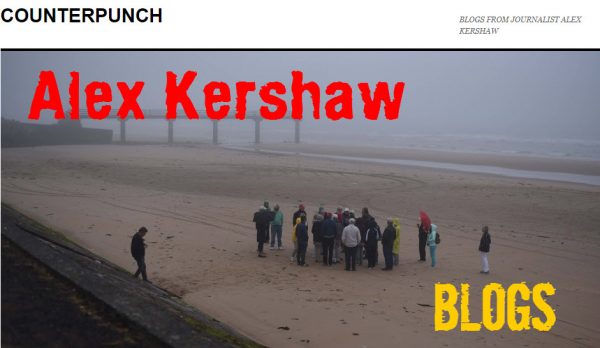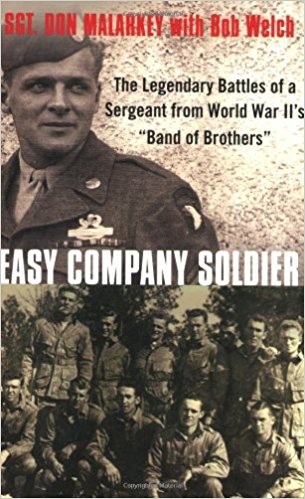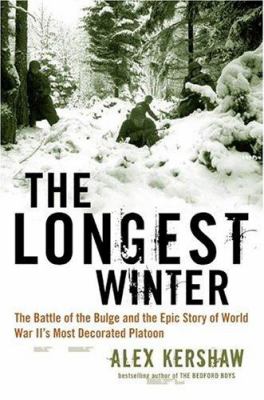The post Survivors of Malmedy appeared first on World War Media.
]]>The delightful Belgian town of Malmédy will forever be associated with the most infamous massacre of American troops in World War II. And yet, but for the presence of an Associated Press correspondent there in early January 1945, it is doubtful that this terrible incident would have ever achieved international notoriety. ‘Nazis Turned Machine Guns on GI POWs wrote Hal Boyle in his January 1945 Stars and Stripes article, and from that first graphic account sprung a plethora of books and articles about the so-called Malmédy Massacre. Few of these accounts are based on facts.
It is unlikely that we shall ever know the precise sequence of events at the Baugnez crossroads, near Malmédy, on December 17, 1944, or the reasons for them. The secret lies with the guilty and the dead. Nevertheless, many corroborated facts are known and a careful analysis of these facts can bring us closer to the truth of what happened.
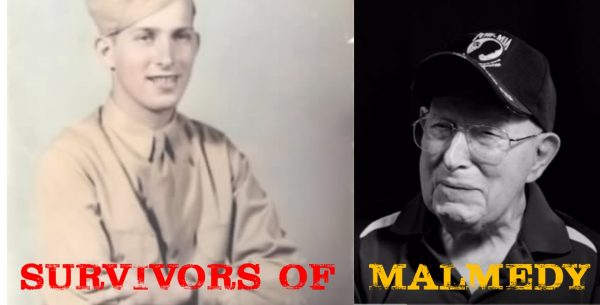
In this film, Emmy Award winning director/producer Tim Gray introduces you to the last survivors of the massacre. Bringing you back to the actual scene, it tells the story as seen through their eyes, their memories of how they escaped execution by the 1st SS Leibstandarte Adolph Hitler.
A moving story, very well documented.
Broadcasted on PBS in the spring of 2018
The post Survivors of Malmedy appeared first on World War Media.
]]>The post The GI Who Hurled His Rifle To The Germans. appeared first on World War Media.
]]>Every move he planned was very thought about and he went by the book only when it would save lives. He was a soldier’s soldier. According to John Primerano from New Hampshire, Meier always called the switchboard when they were short of phones but one day, he didn’t. Second Lieutenant Steve Puiszis, Meier’s assistant, walked up and ordered John to go out there and check if the Lt had disconnected or lost his phone because they could not reach him. When he asked who was going with him, Puiszis replied ” Nobody!”
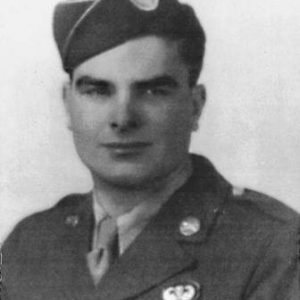
Pfc John Primerano
Indignantly, Primerano glimpsed ammunition, supplies and communications equipment being loaded on trucks and everybody seemed to be preparing to leave. Without the intention to ignore a direct order and frustrated by the idea of being send out alone John muttered “Well, Jesus! Don’t forget me, don’t leave me behind.” Earlier, another section was decimated on the same road he was running, searching for the Lieutenant. Finally, after a one mile sprint, John found that the phone was gone. Realizing that he had risked his life for nothing, he got furious that he possibly also would miss the trucks.
On the way back, the outlines of four men emerged from the dark stretched woods, coming down the road toward him. “ Ducking down behind a tree, I swung my rifle from my shoulder and tried to lower my breath. Three of them were holding their hands over their heads, they were prisoners, escorted by a soldier from A Company. ‘Finally! I found somebody’, the paratrooper said, ‘You are going to have to take these guys back.’ ’Bull!’, I replied, ‘I just came here to check about a phone, I have a truck to catch.’ ’My company commander instructed me to hand these prisoners to the first American I’d see. I must get back on the double because A Co is in one hell of a fight. The sergeant here understands a bit of English’, he finished and then hurried back the same way he came.”
Primerano pointed his rifle at the prisoners and led them towards the trucks. When they reached the nearest junction, the Germans started to zero in on the crossroads with heavy artillery and mortars and forced the four bodies down to the snow covered road. John kept looking up holding his rifle pointed at the POW’s to make sure they didn’t escape. He then informed the sergeant that they were going to make a run for it and that the first one who stopped, would be shot.
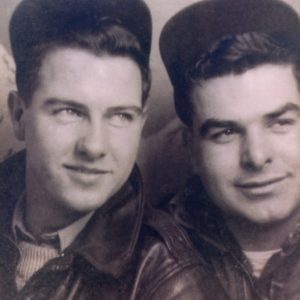
“ I Said ‘Let’s go ..!’ and we ran like hell, but one of them stopped to pick up the mess kit that he just had dropped and I shouted that he was now going to get it. The sergeant translated while we continued. The trucks were just pulling out when we arrived and we bolted after them as fast as we could.” Directly upon them, a Panther tank was firing and the sunken road they were on was lower than the muzzle of the tank could depress. Shells were coming in overhead. “ We made it through the crossfire and had moved close enough to the trucks to make a running jump, to pull ourselves aboard. The Germans leapt onto the bed of the truck first. I couldn’t climb up while carrying a rifle, so I hurled it onto the truck. One of the prisoners caught it. Fortunately they were all so afraid of being killed by their own artillery fire, they just wanted to get out of there and so passed on my rifle to one of the other Americans aside of them. I was relieved to see he didn’t use it what is was built for.”
When they arrived in Bastogne, John turned in the prisoners and took off to find Lt Puiszis. “You were going to leave me there?” , John hollered at him. “All he did was shrug and then said ,’In all of the confusion I must have forgotten about you.’ I called him every name that crossed my mind. Officers should never forget about their men.”
Shortly after, Lt Meier was promoted Captain and won a pass home in February 1945. When reporting for duty again, three months later, Japan had surrendered. John Primerano injured himself by falling down face first while visiting the sunken road in 2012. This formerly unnamed track, a mile north-east of Bizory, is now baptized ‘Purple Heart Road.’
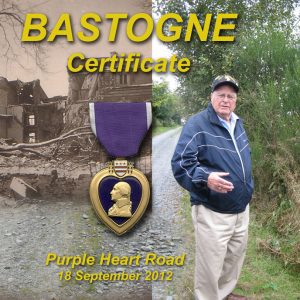
Courtesy of Erwin Janssen

Source: John Primerano/ Cailin Casey/ Erwin Janssen
The post The GI Who Hurled His Rifle To The Germans. appeared first on World War Media.
]]>The post A French Tragedy appeared first on World War Media.
]]>By Alex Kershaw – Author of ‘The Bedford Boys’, ‘ Avenue of Spies’ and ‘The Liberator’
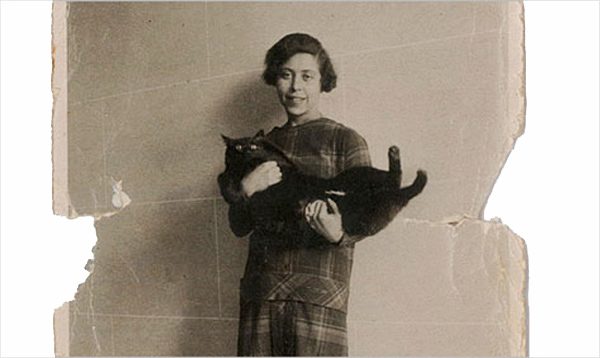
“In life, as on a shipwrecked boat, you have to cut off the hands of anyone who tries to hang on. Alone, you can stay afloat. If you waste time saving other people, you’re finished.”
Irene Nemirovsky, author of Suite Francaise.
On 11 July 1942, 39-year-old Irene Nemirovsky walked alone through beautiful countryside near Issy-l’Eveque, a village in the Bourgogne around two hundred miles south of Paris. Her home was a large building near a former livestock building in the village, just a short walk from the local police station. She had a wonderful view of the Morvan hills. Her husband, Michel, grew beetroot and other vegetables in a large garden nearby and so she and her two daughters had not gone hungry.
The Russian-born writer was a striking woman with large, highly intelligent eyes, her dark hair usually pulled back from her broad forehead. That day, she felt unusually carefree, her sense of dread and doom having abated. She had been forced to write these last months in minute lettering because of a shortage of paper and was near completing what would be her masterpiece, to be titled Suite Francaise. But as a Jewish author she could no longer publish her work and she had little hope, if any, of ever seeing it in print. Nor could she ride a bicycle or take a train to her beloved Paris, which she had fled in 1940 just ahead of the German advance.
She had recently been reading the journal of the writer Katherine Mansfield and had noted certain lines that matched her own mood: “Just when one thinks: “Now I’ve touched the bottom of the sea – now I can’t go down any lower,” one sinks deeper still. And so on for ever.” But she did not feel that way today, 11 July 1942, as she walked in the woods near her home. Pine trees towered above her as she down on her blue cardigan, which she had laid on a dank blanket of rotting leaves. She had a copy of the novel Anna Karenina and an orange in her bag. She listened to a steady drone of honeybees. Later that day, she would pen her last words in a letter to her editor in Paris: “I’ve written a great deal lately. I suppose they will be posthumous books but it still makes the time go by.”
Two days later, on Monday 13 July, the weather was again superb. It was around 10am when a car stopped in the Place du Monument aux Morts in Issy-l’Eveque. There was the sound of footsteps then a knock on the door. Two French policemen had a summons with them. Irene’s two children were with her and her husband. One was called Denise. She heard her parents go into their bedroom. Irene asked her husband to do all he could to secure her release through contacts with important people in Paris, those with connections to the Germans, especially high profile collaborators. There was a “dense silence”, recalled Denise, and then the gendarmes allowed her to kiss her mother goodbye. Irene threw a few things into a suitcase. Her voice frail, she told her children she had to go away for a while. Denise looked at her father. He was clearly very upset but he did not cry. Finally, Denise heard a car door slam shut and then the “dense silence” returned.
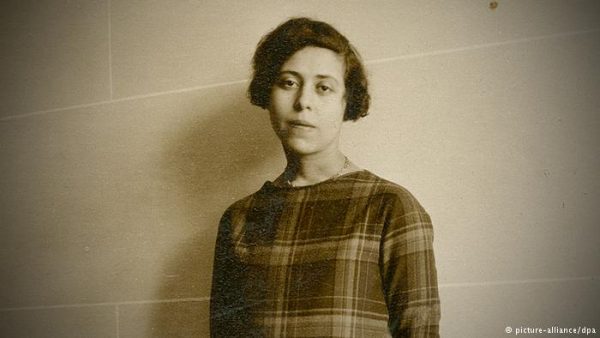
Irene was taken to a police station at Toulon-sur-Arroux, ten miles away. The next day, Irene wrote to her husband: “If you can send me anything, I think my second pair of glasses in the other suitcase (in the wallet). Books, please, and also if possible a bit of salted butter. Goodbye, my love!” Before they could be arrested, Irene’s children, Denise and Elizabeth, were taken to a safe house. They would miraculously survive the war. Meanwhile, Michel contacted anyone who might be able to help him secure Irene’s release. He was convined that some of his contacts, such as Rene de Chambrun and other “influential friends”, would exert pressure and save his wife.
The following evening, 14 July, Paul Epstein, Irene’s brother in law, had a face-to- face meeting with a prominent collaborator, a corporate lawyer called Rene de Chambrun, in Paris. It was Bastille Day but there had been no national celebration. Two days later, Epstein was in turn arrested. Andre Sabatier, Irene’s editor, tried to contact Rene de Chambrun, calling him urgently on the phone several times. It is not known if Rene returned any of the calls.
Paul Epstein was one of thousands caught up in the mass arrests that came to be known as the Grand Rafle, which began on the night of July 16 and lasted well into the following day as 13,152 Parisian Jews, including 4000 children, were arrested and around half of them taken to the Vel d’Hiver, a large velodrome beside the Seine. The round up, carried out with great efficiency by the French police, was the only thing people all over the talked about, it seemed, in every food line, office and hospital ward. The screams of Jews committing suicide pierced the terrible quiet in some quartiers. The famous German writer, Ernst Junger, serving in Paris, noted with matter of fact precision in his diary that he had heard “wailing in the streets” as families were literally torn apart, with adults being separated from their young children.
The medical conditions at the Vel D’Hiver, it was soon learned, were utterly atrocious. There were no lavatories. There was only one water tap for over seven thousand people. According to one account: “It was a rafle conducted in keeping with the best of French conditions, for at noon the policemen returned to their posts to have lunch while higher-ranked and better paid set off to nearby restaurants. Only after the sacred dejeuner could the manhunt continue.”
Women’s cries could soon be heard throughout the Vel D’Hiver. “On a soif!”
“We’re thirsty!” they called out.
Only two doctors were allowed inside the Velodrome, equipped with little more than aspirin. After five days, those incarcerated were transferred in cattle trucks to camps at Pithiviers, Beaune-la-Rolande and Drancy, a modernist high-rise development built in the 1930s also known as La Cité de la Muette – the City of Silence.
A young Parisian called Annette Monod watched a batch of young children, who had been separated from their parents, as they were taken by French police from the City of Silence: “The gendarmes tried to have a roll call. But children and names did not correspond. Rosenthal, Biegelmann, Radetski – it all meant nothing to them. They did not understand what was wanted of them, and several even wandered away from the group. That was how a little boy approached a gendarme, to play with the whistle hanging at his belt: a little girl made off to a small bank on which a few flowers were growing, and she picked some to make a bunch. The gendarmes did not know what to do. Then the order came to escort the children to the railway station nearby, without insisting on the roll call.”
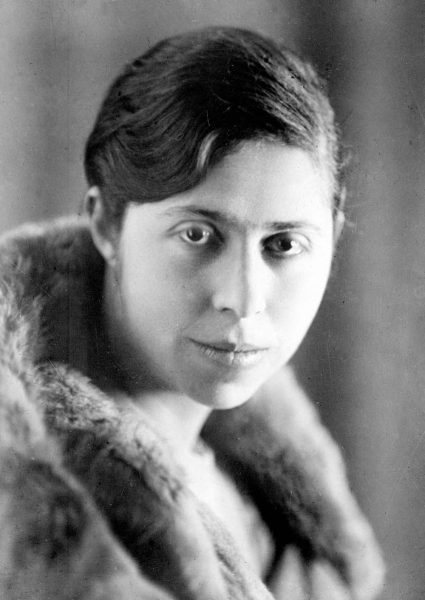
On 27 July, Irene Nemirovsky’s husband Michel wrote a letter to German ambassador in Paris, Otto Abetz: “I believe you alone can save my wife. I place in you my last hope.” To make sure the letter was delivered to Abetz, Michel sent it to his wife’s editor in Paris, asking him to pass it on to Rene de Chambrun for forwarding to Abetz. The next day, Irene’s editor duly sent the letter to Chambrun who may or may not have passed it on.
Meanwhile, along Avenue Foch and elsewhere, trucks loaded down with furniture and other Jewish possessions could be seen after deported Jews’ homes were ransacked. The looters belonged to the Einsatzstab Rosenberg, actually headquartered on Avenue Foch. Eventually, according to the Nazis, this looting saw 69,619 Jewish homes, 38,000 of which were in Paris, “emptied of everything in daily or ornamental use.”
At the end of July, after over 14,000 Parisian Jews had been rounded up, the Catholic Church in Paris made a belated appeal to Pierre Laval on the children’s behalf. But the Vichy premier was adamant: “They all must go.” And they did. Less than four percent of those sent to the east returned. Not one was a child. Those responsible for this genocide later claimed they had no idea that the deportations were in fact to death camps, not some mythical Jewish haven.
It was a shameful time for France, especially for those who had actively collaborated with the SS and Gestapo. Their new German friends were part of something monstrous – the mass murder of their fellow French citizens. It was impossible to pretend one did not know what was happening. Indeed, those with the best connections to the Nazi regime found themselves begged by relatives and others to do something given their influence. At the height of the deportations, Josee Laval, the wife of Rene de Chambrun, was fully aware of the tragedy. She received two letters asking her to help save Jewish friends of friends. Yet she remained utterly self-involved. On the first day of the round up, she had complained in her diary that her beloved father, Pierre Laval, the head of the Vichy regime, was “too busy” to have dinner with her. She did not mention why.
Her husband was as guilty of inaction as Josee. He had been begged in person to help save Irene Nemirovsky. He had the power to do so given his close connection to German ambassador Otto Abetz who had allowed the Vichy official Fernand de Brinon’s Jewish wife to avoid deportation in 1941. Indeed, with the right connections, it was possible to buy or trade anyone’s release. And he knew it. Rene also counted the smooth-talking Rene Bousquet, head of the French police, as an old friend, having belonged to the same rugby team in his youth. Yet there is not a shred of evidence to indicate that Rene took take up Nemirovsky’s case with either Abetz or Bousquet.
It was later learned that Nemirovsky, listed as “a woman of letters”, was deported from France on 16 July 1942 along with 119 other women. Her train had left promptly at 6.15am and arrived on 19 July at Auschwitz. Aged just 39, the author or the finest novel of the German occupation, Suite Francaise, breathed her last after just four weeks at the death camp. Two months later, the US government offered to provide refuge to a thousand Jewish children whose parents had, like Nemirovsky, been deported. Pierre Laval insisted that only “certified orphans” could leave for the US. Since nothing was officially known of the fate of the deported parents, the children were not allowed to go to the US. Most would die in the gas chambers. Nemirovsky’s husband, Michel Epstein, fared no better. He was arrested on 9 October 1942 and sent to Auschwitz. As with 77,000 other Jews in France, he would never return.
The post A French Tragedy appeared first on World War Media.
]]>The post A 360° stroll at the Hürtgen Forest appeared first on World War Media.
]]>By September 1944, the Allied offensive in Western Europe had swept from the Normandy beaches all the way to the West Wall, or Siegfried Line, the formidable defensive position along the German border consisting of concrete bunkers fronted by antitank obstacles. Anxious to move quickly through the West Wall, Major General J. Lawton Collins, commander of the First Army’s VII Corps, plotted an advance south and east of Aachen through a 70-square-mile section of heavily wooded terrain known as the Hürtgen Forest.
Within the Hürtgen lay several massive dams that managed the flow of the Roer River and its tributaries. Rather than the useless real estate of the forest, the flood-controlling dams were genuine strategic assets, but the American planners initially ignored their value and drew up no plans to secure them. Their strategy was fixed upon crossing the Roer and seizing the city of Düren.
Originally intended to put pressure on German forces to keep them from reinforcing Aachen to the north, the Allied assault into the Hürtgen Forest was also dubiously intended to enable the Army to zero in on the industrial centers of the Ruhr Valley. Initial American thrusts during the first phase in late September and early October centered on the village of Schmidt, which U.S. forces attempted to access via the narrow and treacherous Kall Trail.
Terrain in the area was incredibly rough, however, and resupply and armor support severely restricted. Dotted with German minefields, snipers, and rocked by intense artillery bombardments, the forest was also a deathtrap for the advancing troops. Within the first three weeks of fighting, casualties were appalling at over 4,500 American troops killed and wounded — and for the cost, very little ground was gained.
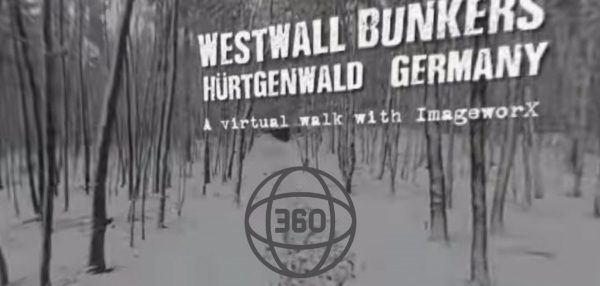
The post A 360° stroll at the Hürtgen Forest appeared first on World War Media.
]]>The post The P-47 Crash at Bastogne appeared first on World War Media.
]]>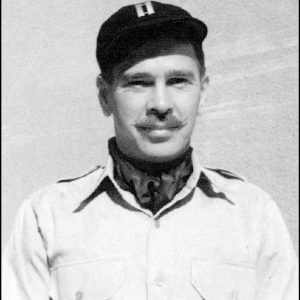
Shortly after Harry hit the snowy ground, 3rd Bn 506 PIR 101 Abn Medic Johnny Gibson managed to pull him into safety.
In this video, WWII historian Reg Jans tells the story.
The post The P-47 Crash at Bastogne appeared first on World War Media.
]]>The post U.S. Mortars of World War II appeared first on World War Media.
]]>When history is visceral and experiential, it is typically more compelling and engaging than when it is taken out of the human context. The subject is notorious for being presented in dry and uninteresting ways, but that is mainly because most people are exposed almost exclusively to the sterility of classroom lecture. When it comes to the history of the Second World War, classroom instruction is critical to understanding the big picture of the conflict, but bringing clarity to the individual soldier experience is something that is typically best edified by good old-fashioned fieldwork.
by Martin K.A. Morgan and very special thanks to Brian Domitrovich
This can be done by visiting a battlefield or, in some countries, by live-firing the weapons used in a given war. As described in my January 22, 2017 post about shooting the German MG.42 machine gun, a day at the range can offer a powerful and memorable insight into the lives of those who experienced combat first hand. But even in the U.S.A. where it is possible to own just about every type of weapon used in ground combat between 1939 and 1945, one category is usually missing: mortars. Each country involved in World War II used them to great effect in circumstances where indirect, high-angle fire was needed but field artillery fire was unavailable. They were dangerously accurate, and they could operate in rain or shine – in the blistering heat or the numbing cold.
Despite their prolific use and significant importance to the story of World War II combat, most American collectors do not own mortars, and as a result they are largely only understood in the abstract. We read technical details about weight, range, accuracy and explosive power, but we just do not have access to them like we have access to rifles, pistols and machine guns. For that reason, I recently traveled to western Pennsylvania for a day at the range with Brian Domitrovich, owner of three live U.S. World War II mortars: a 60mm, an 81mm and a 4.2-inch. Brian’s possession of these weapons is regulated by the National Firearms Act of 1934, which designates them as “destructive devices” and holds him up to stringent qualifications for their ownership.
For him to be eligible to purchase these registered destructive devices, Brian had to be a U.S. citizen over the age of 21 with no criminal arrest record, he was required to pay a one-time $200 transfer tax for each weapon, and he had to wait between six and twelve months while each transfer application was reviewed by the Bureau of Alcohol, Tobacco, Firearms and Explosives (the “BATFE”). In other words, the 1934 National Firearms Act created a heavily regulated category of civilian ownership that Brian qualified for, thus allowing him to make it rain 60mm, 81mm and 4.2-inch mortar rounds. We hauled all three weapons out to the Beaver Valley Rifle and Pistol Club near the township of Patterson Heights, Pennsylvania and spent the day putting each tube through its paces.
For each mortar, we fired only inert projectiles – meaning that only propelling charges were used and none of what we fired exploded downrange. The only partial exception was the M2 mortar, through which we fired BATFE-approved 60mm reusable training projectiles made exclusively by ordnance.com. These projectiles are equipped with a proprietary fuze assembly that produces a non-lethal impact explosion through the use of a point-detonated 20-guage blank shotgun shell. Although they do not distribute deadly fragments, they do produce a report downrange that simulates the experience of shooting a 60mm M49A2 high explosive round.
The smallest and lightest of the three mortars being demonstrated that day, the M2, consists of a 12.8-pound tube, a 16.4-pound bi-pod/mount, and a 12.8-pound baseplate. With an overall 42-pound weight, the M2 gave U.S. fighting forces during the Second World War the kind of handy mobility that made it easy to provide company-level fire support, and even advance with an attacking echelon if necessary. Although it can deliver concentrations of fire to a maximum range of 2,000 yards, we had to keep our rounds within 200 yards so as not to lose any of the five-pound reusable training projectiles. When we went downrange to recover the rounds, they were all sticking out of the ground like lawn darts within a few feet of each other.
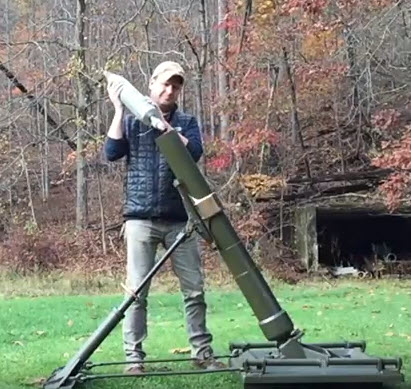
Moving up in size and weight, we fired the 81 mm M1 mortar next, but the space constraints at Beaver Valley Rifle and Pistol Club prevented us from realizing that weapon’s full range potential. With a full increment charge and a 6.87-pound M43A2 high explosive round, the M1 mortar could hit a target almost 3,300 yards away, giving it a significant range advantage over the 60mm M2 mortar. Using a minimum propellant charge, we were able to keep all of our 8-pound, 81 mm projectiles in one area but they still dug deeper into the ground than the lighter 60mm projectiles did. The M1’s greater capabilities come with a cost though: greater weight. With a 44.5-pound tube, a 46.5-pound mount, and a 45-pound base plate, the total package is almost 100-pounds heavier than the 60mm mortar.
Despite its weight though, the 81mm mortar was an important part of the Table of Organization and Equipment of U.S. Army and U.S. Marine Corps maneuver battalions throughout World War II. It was even a tool used by airborne units, and was dropped in parachute bundles during Operations Neptune, Market Garden, and Varsity. Ground combat units appreciated the 81mm mortar because of its mobile and hard-hitting qualities, and that is why it occupied a prominent place in the arsenal of American fighting forces during the Second World War.
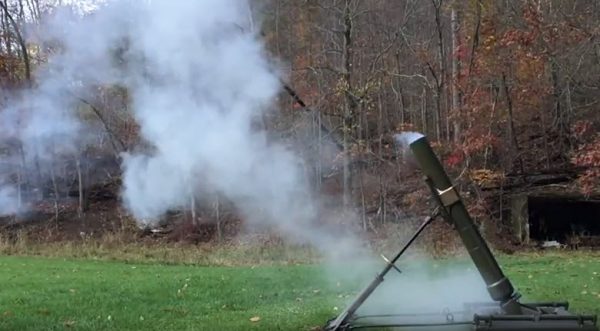
Last but not least, we fired the mighty 4.2-inch M2 chemical mortar. Developed before World War II as a means of delivering toxic agents (thus the name “chemical mortar”), the U.S. Army Chemical Weapons Service eventually turned the 4.2 into a weapon capable of delivering high-explosive fire. But TNT, and Mustard Gas rounds were not on the menu for our live fire exercise, so M335A2 Illuminating Rounds were used instead. Weighing 17-pounds each, they tumbled through the air like parabolic watermelons and half-buried themselves in the mud at the very edge of the designated long-range lane. While convenient for our purposes, the M335A2 rounds need the weight of the illuminating chemicals in them to stabilize in flight. The ones we fired that day were inert and (therefore) empty, so there was only so much the barrel could do.
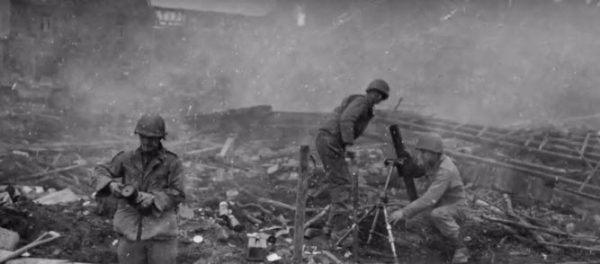
Unlike the 60mm and the 81mm mortars, the “four deuce” uses a rifled barrel to stabilize its projectiles in flight, and those projectiles engage that rifling through the use of a brass obturating plate. While the barrel did its job with no problem and the rounds caught the rifling as they were designed to, after leaving the tube’s muzzle at 700 feet per second they gradually lost their stability and started to tumble. Still, it was lots of fun throwing them skyward in an offering to the spirit of Saint Barbara. Once again though, we had to generate as little range as possible, which was not an insignificant challenge with the “four deuce.” That weapon can throw a round out to 4,400 yards (2.5 miles) and we had only 300 yards to play with, so we were barely scratching the surface of what that tube could do.
Weighing-in at 333-pounds overall, the “four deuce” is a beast of a weapon. Just to put this in perspective, it weighs the same as eight 60mm mortars or two and a half 81mm mortars. It’s base plate alone weighs as much as I do, which only became an issue when we had to carry it up the stairs from Brian’s basement to get it to his truck. Every bit of that effort was worthwhile though because it offered a priceless opportunity to appreciate the difficulty of manhandling this weapon that contributed so meaningfully to allied victory in World War II. The 4.2-inch mortar fought for the first time in the Sicily campaign in 1943 during which it fired over 35,000 rounds in 38-days. It then went-on to fight it’s way across difficult terrain in Europe and islands in the Pacific.
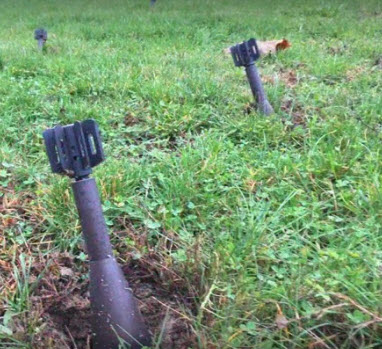
The Army used it, the Marine Corps used it, and even the U.S. Navy used it on landing craft converted into mortar gunboats under the designation LCI(M). Though it never delivered a gas attack in combat, it did put down vast quantities of TNT and smoke during World War II and again during the war in Korea. Having the chance to shoot the “four deuce” – alongside its 60 mm and 81 mm cousins – provided the kind of visceral and tactile experience that I value because it helps bring another element of the story of World War II into sharper focus.
The post U.S. Mortars of World War II appeared first on World War Media.
]]>The post Tank Training Site in England appeared first on World War Media.
]]>by Stuart Burgess
It originally consisted of an accommodation area, workshop and maintenance buildings, dummy landing craft slipways, specific training structures, a large tank park and numerous tracks and roadways linking the various components.
Due to the secret nature of this establishment relatively little is known about its layout and operation. Following its decommissioning, the site was cleared and the majority of above ground structures demolished. Despite this, significant evidence is preserved at this site in the form of foundations, floor slabs, track ways, and areas of hard-standing as well as the structural remains of the landing craft slipways. There is also at least one extant building with significant portions of a second standing nearby. Many of these remains are relatively slight and are in danger of being destroyed or simply being lost. To mitigate against this and as an aid to further the understanding of this site, a survey of all the known extant remains was carried out. The main the aim of the survey was to produce a plan of the training establishment and to undertake a basic descriptive record of the remains.
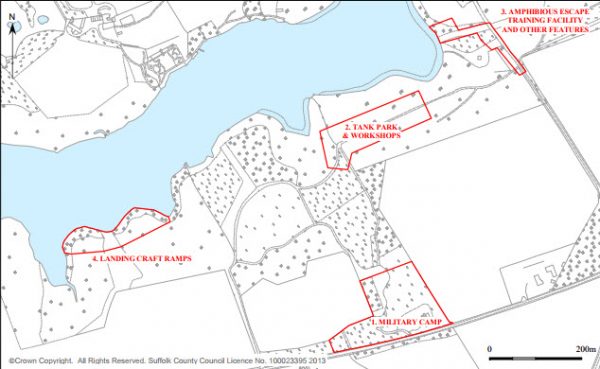
The area around Fritton Lake, situated in the Suffolk parish of Somerleyton, Ashby and Herringfleet (formerly three separate parishes, now a single entity), was used by the 79th Armoured Division of the British Army, during the 1940’s, for the development of amphibious tanks and as a training establishment for crews to familiarize themselves with their use. The main drive behind the training program was the proposed D-Day landings, which comprised a significant part of the Allied invasion of Europe leading to the end of World War Two. The amphibious tanks were known as DD Tanks, which stood for ‘Duplex Drive’ and was a reference to the tank’s twin drive system needed to incorporate propellers for use when floating. The act of using the tank on water was known as ‘swimming’ and they were often confusingly referred to as ‘swimming tanks’.
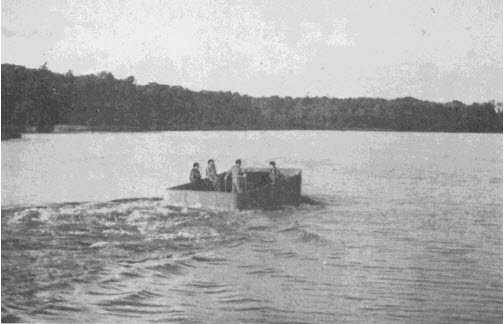
The site was in use until 1947 after which it was dismantled and the site returned to the original owners. Part of what had been an area of accommodation for men based at the site, including at least two extant buildings, was leased to the Scouting Organisation for use as a Scout Camp. The remainder of the land was restored and replanted as cover for game birds or returned to forestry. The entire site then lay undisturbed and virtually forgotten until the early part of the 21st century when the then Country Park Manger of the Somerleyton Estate, Stuart Burgess, recognized that significant components of the camp survived within the woodland on the south side of the lake and undertook a program of personal research and investigation into the site’s history with the ultimate aim of bringing recognition to the site’s historical
significance and to further understanding of the important role it played in World War Two. Although numerous remains are present scattered across the area, no attempts to assess the extent of the site’s survival had been undertaken. In order to rectify this, funding was obtained from the European Interreg IV A Project to undertake a basic survey of the extant remains.
Valentine and Sherman Tanks were adapted to make them amphibious, so that they could “swim” to shore and provide close fire support to the first wave of troops landing on enemy beaches. These tanks were part of a series of tanks that had been modified to do something more than just fight in the regular way, and were collectively known as “funnies”. The Lake became a significant training facility in 1943 and went on to train in excess of 2000 men prior to D Day and a further 500 after D Day. The DD tanks and their crews proved themselves as key and effective weapons for the D Day Landings, and as such became versatile in subsequent European Operations associated with Estuary and River crossing.
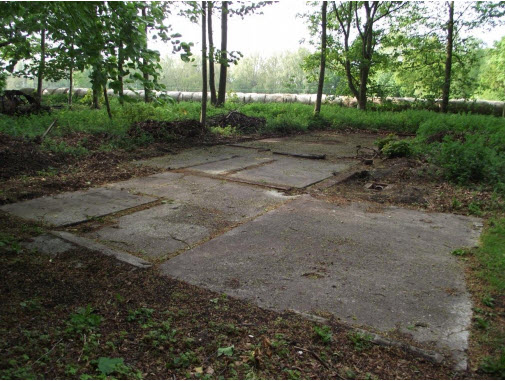
The significance of the Freshwater Training Wing cannot be underestimated in relation to the development of the Duplex Drive Tanks. Its archaeology concerns the Military Camp and functional infrastructure associated with the provision of elementary training, tactical development, amphibious tank escape as well as post war experimentation and trials. The 60 acre site is well preserved, with surviving features such as a tank park, contemporary Landing Craft slipways, subterranean structures and the footings of a large number of huts, stores and other buildings connected with the workshop and maintenance facility.
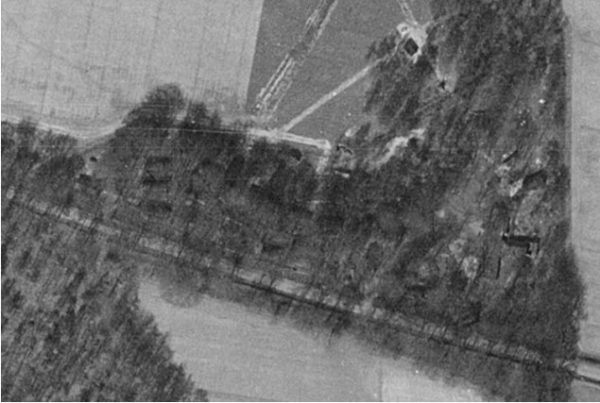
Two regiments – the 15th/ 19th Hussars and the Staffordshire Yeomanry undertook training at Fritton in preparation for their role in crossing European rivers with the DDs. As it transpires only the Staffordshire Regiment eventually undertook River Crossing Training at a special wing at Burton upon Stather, before undertaking European Operations with their DD tanks. During these operations it became evident that the heavy Sherman DDs encountered difficulties exiting the soft silty riverbanks, and to this end Fritton – as well as Burton upon Stather – assumed a secondary role – that of overcoming river obstacles. Additionally at this time, the 79th Armoured Division were being replaced by the Assault Training and Development Centre (ATDC). Research and trails continued at Fritton for a further 18 months under ATDC, before they were replaced by SADE – Specialised Armour Development Establishment.
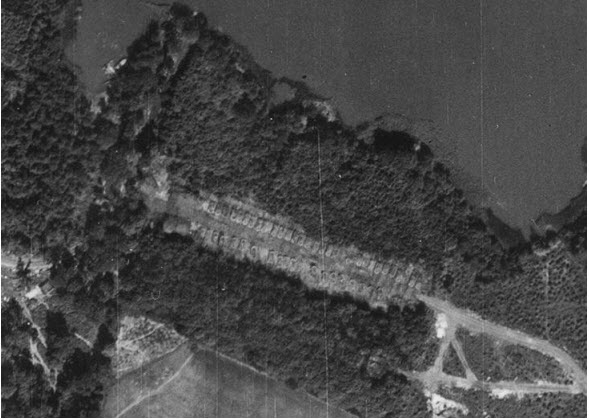
Training continued at Fritton under SADE until 1947, where upon swimming tanks were becoming larger and more impractical to be launched at sea. A facility continued at Gosport for a number of years, and by 1951 that too was eventually closed. Infrastructure at Fritton was removed by 1950 and the woods and lake returned to the Estate. Part of the military camp was leased out to the Scouting Organisation, and the remainder of the land was replanted as cover for game birds and forestry.
Thus Duplex Drive Tank Development came to an end. Its role on D Day was a unique and significant. As a weapon hurriedly devised and tested during WWII it proved its effectiveness as a dual purpose vehicle. Every credit should go to the men who developed, trained and ultimately operated these tanks, many of whom were present at Fritton Lake from 1943-1947.
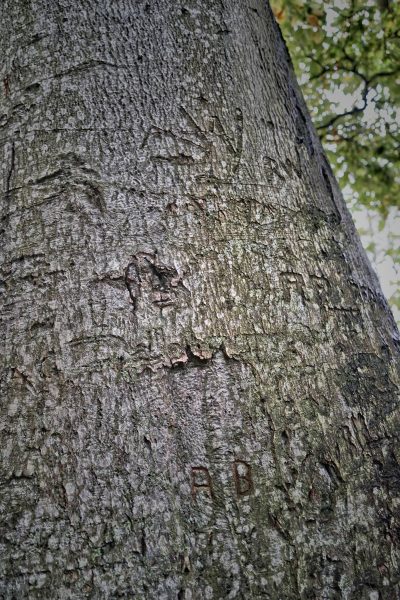
Photo by Jo Segers
The post Tank Training Site in England appeared first on World War Media.
]]>The post Mardasson appeared first on World War Media.
]]>‘The Belgian people remember their American liberators-4 July 1946’ was tattooed on top of the Mardasson hill on Independence Day, 1946. General Gerald J. Higgins, the Assistant Commander of the 101st Airborne Division in Bastogne and Mr. Paul van Zeeland, president of the ‘Association Belgo-Américaine’ were among the officials attending the ceremony.
Some soil, ‘soaked with the blood of American soldiers’, excavated from the hill, was collected in a green malachite urn that day. This grim memento of American sacrifice was presented to President Truman in Washington on July 10, 1946 by the Belgian Minister of Defense Colonel Raoul de Fraiteur and Baron Sylvercruys, the Belgian ambassador to the US. The urn containing the ‘Bloody Soil’ is now preserved in the Harry S. Truman Library and Museum in Missouri.
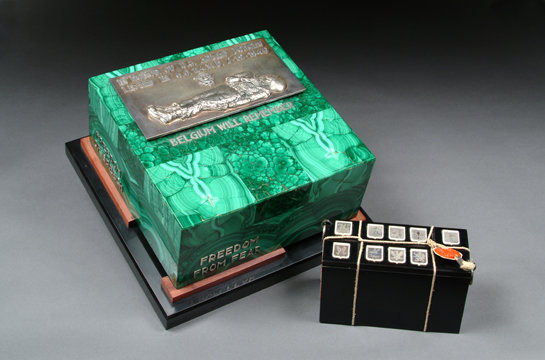
Urn with the ‘Bloody Soil’ of Bastogne. Photo courtesy of Harry S Truman Presidential Library & Museum
The construction of the thirty nine foot high monument was seriously hampered to the waterlogged ground. According to local residents Mardasson originates from the French ‘mare à joncs’, which means pond reeds, while in the Walloon dialect it stands for ‘muddy fields’. Hundreds of tons of dirt were scraped off its peak to obtain a solid foundation for building the largest memorial dedicated to the eight hundred thousand American soldiers who participated in the ‘Battle of the bulge’, until today , the largest ground battle fought in the history of the United States Army. The outer pillars bear the insignia of the participating units while the interior summarizes the course of the battle as noted by the Chief US Army Combat Historian, General S.L.A. Marshall. All fifty states of America are alphabetically ranked on the crown except for Pennsylvania, which was shifted when Hawaii and Alaska became part of the Union, in 1959. A stairway on the southern edge of the site leads you to a crypt that stages three altars representing the Catholic, Protestant and Jewish religions with the Chimes of Liberty resounding every fifteen minutes.
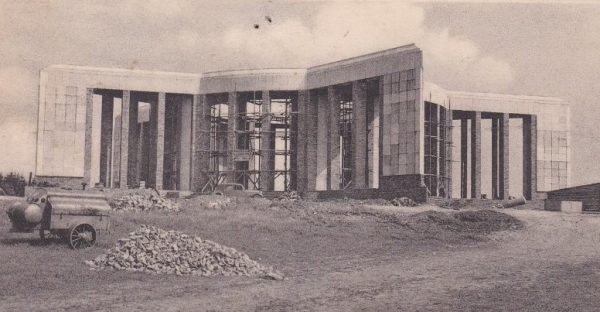
The Mardasson hill was most suitable to carry a large monument because of its geographical position, a high ground one mile north east of the city, to provide a panoramic view of the surrounding area and secondly the historical significance of it as this was the closest the Germans ever came to Bastogne.
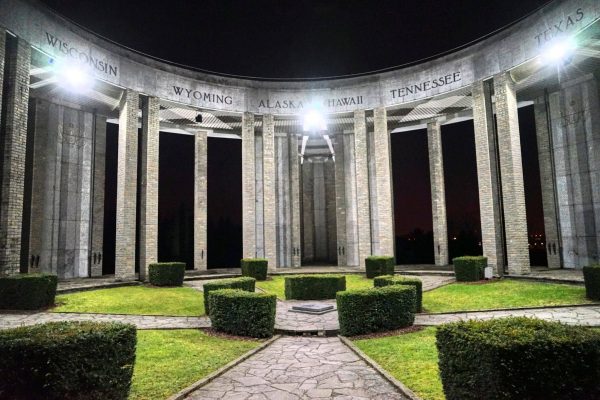
Photo courtesy of Jo Segers
On the southern slope, the 907th Glider Field Artillery Battalion had set up two batteries of 105 mm Howitzers to provide fire support to the 501 PIR, with A battery on the eastern side, adjacent to a quarry and B battery near the rail way bank to the west. A reconnaissance patrol was sent to the north on the 18th of December which resulted in a firefight with an advance party from the 26 Volksgrenadier Division. Later, two German corpses were collected from this swampy pasture.
On July 16, 1950 the Memorial was officially inaugurated in the presence of General Anthony C. McAuliffe, Acting Division Commander of the Screaming Eagles, who was bestowed Honorary Citizenship of Bastogne.
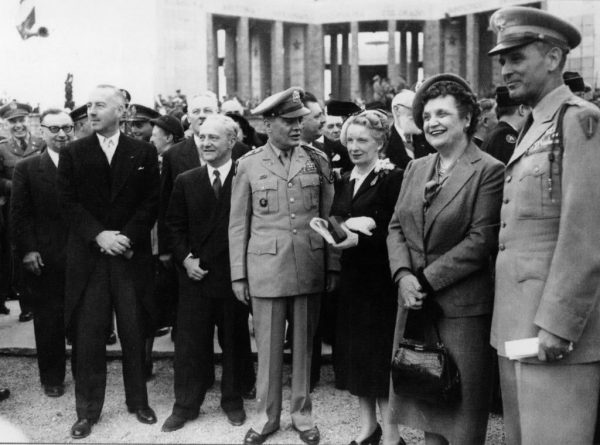
Architect: George Dedoyard Constructor: Felicien Calay Illustrator Crypt: Fernand Léger
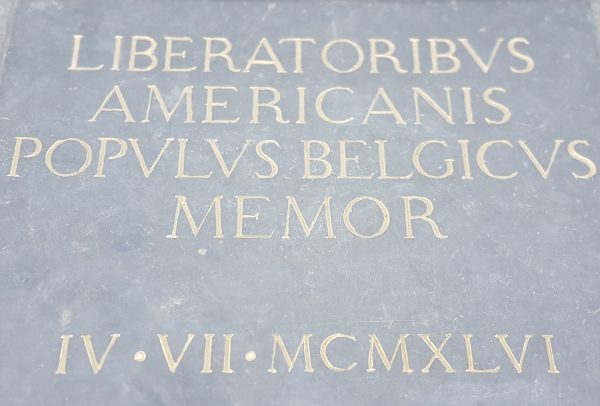
The post Mardasson appeared first on World War Media.
]]>The post Journey Home to the USS Arizona appeared first on World War Media.
]]>The mission of the non-profit World War II Foundation is to produce educational films and create initiatives recognizing the bravery and enormous contributions made by the veterans and survivors of World War II so that future generations appreciate the determination and sacrifices that enabled perpetuation of our basic freedoms.
For this film, premiering on Saturday November 4 at Jane Pickens Theater & Events Center, Newport, RI, the Foundation follows the family of USS Arizona survivor Raymond Haerry as they return to Pearl Harbor to place their father’s ashes back aboard the great battleship.
The remains of more than 900 sailors killed that day aboard the Arizona remain inside. Of the 334 who survived, 41 have asked over the years to rejoin their fellow sailors upon their death.
“I believe this is the most impactful film of 19 we have done to date due to the message it delivers, which is that people still remember and care about what that generation contributed and suffered through to save the world.” Tim Gray, Chairman of of the WWII Foundation, says.
“It’s an unspoken bond these guys had with each other, these were Ray Haerry’s brothers. And the Arizona was their home.”.
The hour-long documentary, narrated by actor Matthew Broderick, will air nationally on American Public Television in the fall of 2017.
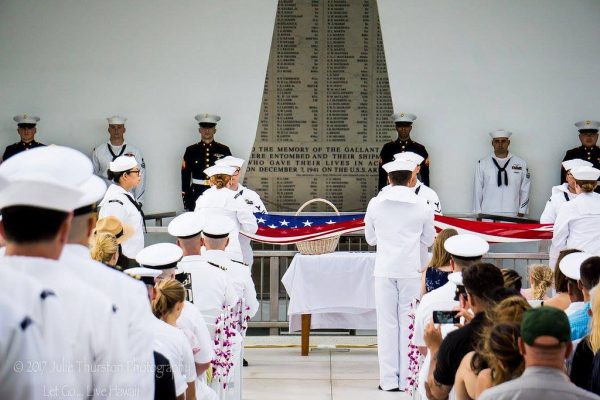
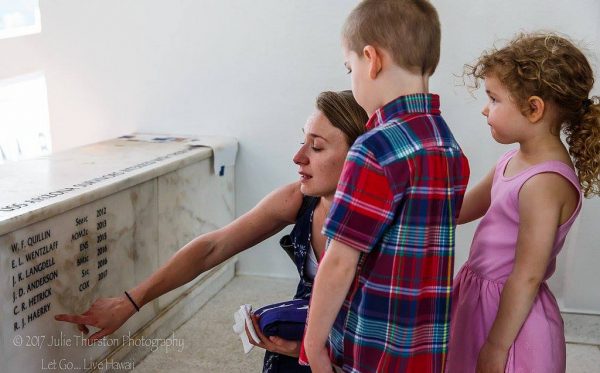
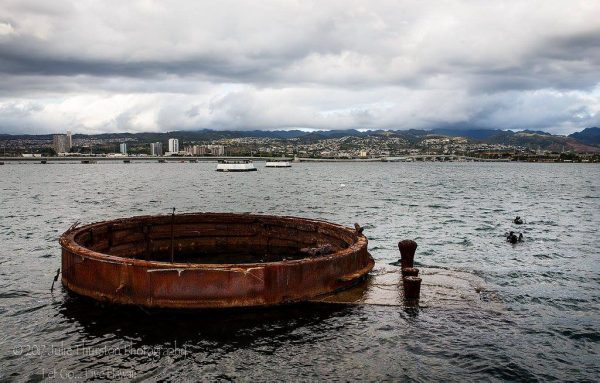
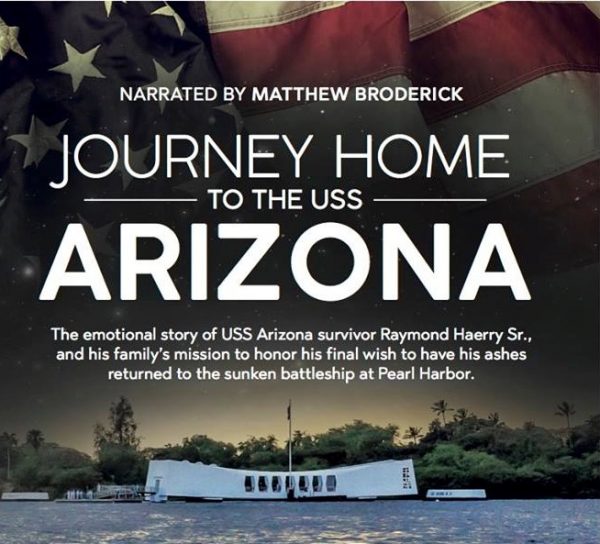
The post Journey Home to the USS Arizona appeared first on World War Media.
]]>The post From Gliders To The Bois Jacques appeared first on World War Media.
]]>Ben, a native of Avery, Idaho, was scooped up by the draft like a lot of men after the attack on Pearl Harbor. “The Adams County draft board ordered me to go to Milwaukee for examination on Dec. 3, 1942. I went along with a bus-load and since I was still breathing, passed the ‘physical’ exam and was put on class 1-A.” After initial processing at Ft. Sheridan, Illinois, Ben was sent to Ft. Bragg, North Carolina, to join the 82nd Airborne Division’s 326th Glider Infantry Regiment.
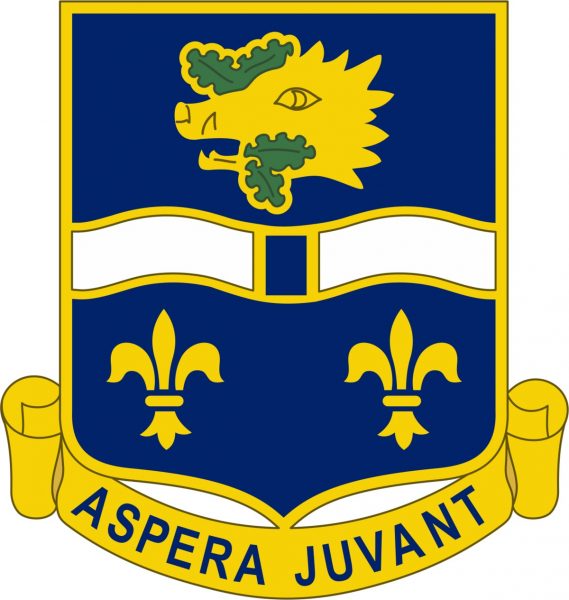
Ben completed his basic training at Ft. Bragg, and afterwards, he and the other members of the 326th were transported by train to Alliance, Nebraska for another grueling round of training. While in Alliance, Ben was assigned to an 81 mm mortar platoon and repetition became the platoon’s the catchphrase. “We took the gunner’s tests and observers tests time after time. We also took many, many glider rides.” As they trained, the men couldn’t help but notice that the rate of attrition for young officers was quite high, with 2nd lieutenants seemingly arriving and leaving almost the same day. As a result, Ben and his fellow glider riders often joked that the purpose of their training was to “train officers.”
After training stints back at Ft. Bragg and then at Camp Mackall, the 326th readied itself for movement to England. Many senior Allied leaders feared that there would extensive casualties among the parachute units during the invasion of Normandy and felt it was necessary to reinforce those units. As a result, many of the 326th troopers received transfer orders to paratroop units once they arrived in England.
While Ben wasn’t one of those transferred, he eventually volunteered for the paratroops as well. “Our willingness was immediately seized upon and off we went to Jump School (in England)!” After completing the training Ben received his Parachute Wings. “Along with being (awarded) one of the most prestigious badges in the services, I started collecting the famous “Jump-Pay” of an extra $50.00 a month for hazardous duty… we had gotten out of the “flying coffins” (and we were) happy to be in that special group. We wore our new “Wings” very proudly,” said Ben.
Ben received orders assigning him to Company E, 506th PIR. After arriving at their billeting area of Nissen Huts and horse stables, he reported to the company commander, Captain Richard Winters. The youngish looking captain, in reviewing Ben’s service jacket, noticed that he had qualified expert on the 81 mm mortar. “He asked me if I preferred being in a mortar platoon. My thinly restrained reply was, “Sir, if you had trained constantly for 18 months in 81‘s where do you think you would prefer to be?’ His reply was, I’ll talk to the Hq. Co. Commander, and if he needs a mortar-man, I’ll transfer you”. It would not be the last time he would serve under Captain Winters.
“So with that (transfer) I had found a “home” in the Hq. Co. 2nd Bn., doing the things I had spent all my time up to now training for…I also learned some combat tricks from these seasoned troopers…the few survivors from Normandy’s battles!” Being several years older than the majority of his fellow troopers as well as married, the men quickly took to calling Ben, “Pop”.
With Ben firmly entrenched in the 81 Mortar Platoon, alerts quickly arrived for the unit to take part in several combat jumps in France. “We actually got sent to Airfield Marshaling areas and scheduled for missions 3 different times. Each time the mission got canceled just before we took off. One time we were totally loaded in the planes, with motors revving up just as the call came down that Patton had already taken the area we were scheduled to jump on and the mission was canceled! What a letdown and big relief in a way all at the same time.”
The letdown wouldn’t last long for Ben. On 17 September 1944, the alert became real. The men would jump into Holland as part of Operation Market-Garden. During the approach to the drop zone, Ben’s C-47 took quite a bit of ground fire. One round hit the starboard wing tip, causing the aircraft to pitch to that side. This threw Ben and the other paratroopers away from the jump door. They struggled to move to the door and literally had to throw themselves out.
Ben’s ‘adventure’ did not end there. He descended rapidly due to his weight and the weight of his attached equipment. That caused him to fall into the top of an orange parachute carrying an equipment buddle. With his heart racing, Ben hurriedly ‘walked’ off the chute and continued his descent. Even his landing ended up giving him trouble. When Ben made contact with terra firma, the butt stock of his M1 Garand rose up and socked him in the chin. He had a sore jaw but at least he was on the ground and in one piece. As he dusted himself off and adjusted his equipment, Ben heard German 88’s firing in the distance.
The sound of those big guns signaled the start of a campaign that began with a number of moves and counter moves as the 506th attempted to keep their portion of Hell’s Highway open for business. The men found themselves marching off like firemen attempting to put out house fires, only to be ordered off to another location to close off German penetrations in a different portion of the highway. During one 24 hour, seesaw period, Ben had three different rifles destroyed by enemy fire and each time he obtained a replacement from a wounded or dead paratrooper.
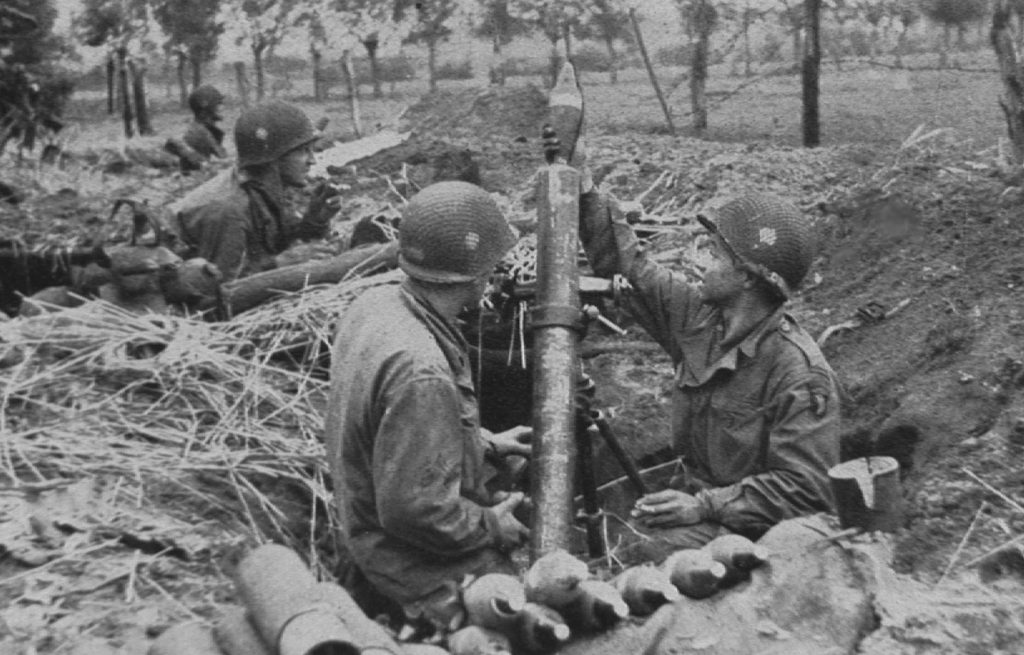
Finally the seesaw fighting ceased as 2nd Battalion was ordered to The Island. Ben would spend the remainder of his time in Holland firing his mortar in support of the line companies while alternately bailing the water out of his mortar pit. While the conditions were miserable, Ben always remembered the kindness of the Dutch people, especially their willingness to share their meager rations with him and his fellow paratroopers. One of his fondest souvenirs from Market-Garden was a small Dutch flag given to him by a young mother as they approached Eindhoven. He kept that flag right next to a swatch of his parachute that he had cut out after landing. After seventy-six days on the line, Ben and the rest of the 506th, was pulled back to Mourmelon, France to rest and refit. The respite did not last long.
Ben and his buddies had barely spent twenty days in Mourmelon when the alert came. They had been dreaming of passes to Paris and the upcoming Turkey dinner that would undoubtedly accompany the arrival of Christmas. But it was all for naught. His platoon sergeant told them to gather their gear and be prepared to move out. “Grab whatever you can because I don’t know when we’ll be resupplied. “But Sarge, the ‘81’ is still at the armory for maintenance!” It didn’t matter, he said. Orders were orders and the man giving those orders was none other than his former company commander, Captain Richard Winters.
Ben and the other members of his platoon rummaged through their duffel and barracks bags, hoping to find a stray clip of ammo, grenade or K ration. Pockets were stuffed with extra socks. They were critically short of ammunition for their mortar, winter clothing and many other supplies. As they mustered outside the barracks near the cattle cars that would carry them into battle, the men came to the stark realization that they had about five rounds of rifle ammunition per man. This was hardly the ideal way to head into a combat situation.
As they drove through the night, the situation was not lost on Ben and his fellow mortar-men. Thankfully, all hope was not lost due to a bit of happenstance. “The picture was totally bleak already and we hadn’t quite arrived yet! The bright spot, the ONLY bright spot, was that as we went along sometime during the trip, we passed an abandoned jeep with a load of rifle and machine gun ammunition. We finally got some of the precious ammo we needed.”
Sometime after dark, the convoy arrived outside the small Belgian town of Bastogne. They had stood in the back of the cattle cars, huddled together to share body heat, but by the time they arrived the men were cold and stiff from the long, frigid trip. As they attempted to regain feeling in their arms and legs, Ben and the others were ordered to form up into columns. They proceeded to walk towards an open field where they were ordered to dig defensive positions.
The next morning, the battalion was ordered to move into a wooded area that they would come to know all too well over the next few weeks. The name of that forest was Jack’s Woods or the Bois Jacques. Once again, Ben and the others found themselves digging in. “Why the hell are we digging mortar pits when we ain’t got no mortar?”, one of Ben’s platoon mates complained. “Don’t worry…they’ll catch up to us…hopefully before the Krauts come-a-callin’,” was the reply. Hours later, a jeep pulled up bearing their mortar and some ammunition. They were back in business.
On December 23rd, the men received a welcome present…an airdrop of supplies. “The sun broke through and Glory-be, the damn sky was FULL of Allied/American supply aircraft! What a relief! Oh! It was a gorgeous and thrilling thing to stand there in the cold and snow up to your “you-know (what)” and see the equipment bundles full of food, ammunition and at last some winter clothing etc., tumbling out of the planes, the chutes billowing out and their loads whomping down in to the snow.”
In addition to ammunition, food and medical supplies, the men received the gift of warm feet. “As we retrieved the bundles, first we cut up the bag material and wrapped our feet in it, to help keep our feet warm. Then we proceeded to take care of the supplies and ammunition we so sorely needed. How great it was to have warm feet!”
The following day, according to Ben, the German artillery had been quiet and as a result, the men of the platoon decided to celebrate Christmas by trimming a tree. They scrambled to find anything with color…scraps from colored supply parachutes, but mostly they decorated it with strings of foil chaff that had been dropped by friendly aircraft to fool German radar. “Then we put some full and empty ration boxes to represent our presents under the tree. We even used a couple of live mortar shells! For a brief few moments on Christmas each of us was at home with loved ones! At least in our minds!”
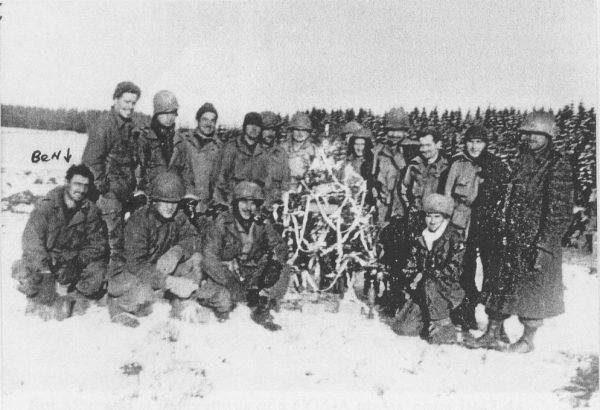
Once word spread of their tree, Regimental Headquarters sent a photographer down to take their picture. The platoon gathered around the tree, with Ben kneeling at the far left. The other men featured in the photo were: (Kneeling, left to right) PFC Hugh B. “Ben” Rous, PFC Wilford J. Grant, PVT Stanley L. Hagerman, T/5 James G. “Jim” O’Leary, (Standing, left to right) PFC John C. Joyal, SGT Wyndell E. Russell, S/SGT Charles L. Roeser, PFC Darce K. Hardin, PFC Nicholas J. “Nick” Blahon, Joe MacKorn, K. Chidden, S/SGT Norman A. Jorgensen, PFC Lincoln F. Keeler Jr., PFC Joe C. Trujillo, PFC Harry A. Gibson, PFC Steve Mihok, unknown Reg HQ man.
After all the excitement of the photo opportunity had died down, the platoon got back to their ‘normal’ routine in the woods. They fired in support of several patrol actions for the next 10 or so days until they received the order that they would be moving out. After Company E and elements of 3rd Battalion cleared the town of Foy, Ben and the mortar platoon moved up towards the town of Noville.
“We had started to dig a mortar emplacement and some foxholes. Suddenly I dove into my foxhole going in headfirst. I don’t recall ever going in head first before, but it was lucky I did because I caught a fragment from a “screaming meemie” right through my calf of my leg. Later it was described as a two and one half inch by six and one half inch wound! I recall thinking that it was a good thing I had gone in head first…what if my neck had been sticking up there?”
Ben’s quick-thinking sergeant, a man named Leland Peterson, got on a field phone and called for a medical jeep to come and evacuate his stricken mortar-man. “We hadn’t seen a vehicle for days it seemed. Suddenly there it was! Ready to evacuate me to Bastogne proper which was only two miles way. Later on I was moved to an evacuation hospital near Paris. Finally, I had my pass to Paris and dang it, here I was with only one good leg! Oh, the cruelty of war!”
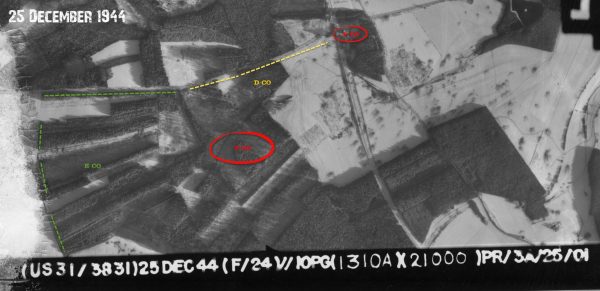
Ben’s stay in the hospital took him from Bastogne, to Paris and then to England on January 21st. He boarded a ship in late April 1945 and by May 13th, he was back in the States. Ben Rous had come a long way to get home. Throughout it all he kept a smile on his face and that smile can still be seen in a relatively obscure photo of a group of dirty soldiers gathered around a Christmas tree in the snow.
Ben Rous passed away in 2007 and was active in both the 82nd Airborne Division and 101st Airborne Division association’s right up until his death. He was buried with full military honors.
The post From Gliders To The Bois Jacques appeared first on World War Media.
]]>The post 82 Airborne Division Walk 2018 appeared first on World War Media.
]]>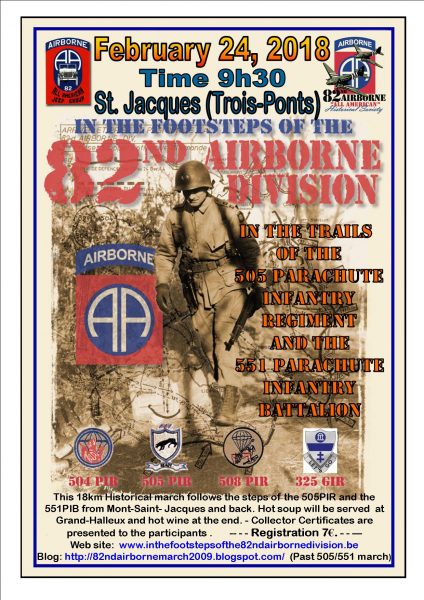 The march will take you to the Belgian towns of Fosse, Grand-Halleux, Dairomont and Rochelinval. Some 82nd Airborne Division’s Veterans Families intend to come over to participate as well as several European re-enactment groups. The logistic support will be provided by WWII vehicles from the 82nd Airborne “All American“ Jeep Group.”, founder and organizer Emile Lacroix says.
The march will take you to the Belgian towns of Fosse, Grand-Halleux, Dairomont and Rochelinval. Some 82nd Airborne Division’s Veterans Families intend to come over to participate as well as several European re-enactment groups. The logistic support will be provided by WWII vehicles from the 82nd Airborne “All American“ Jeep Group.”, founder and organizer Emile Lacroix says.
When: February 24, 2018 Time: 09h30
Start/Address: Restaurant Ferme Bodson – Mont Saint Jacques, 15 – 4980 Trois-Ponts
Distance: 18 Km (11 Miles) Registration fee: 7 Euro pp
Info + Reservation Accommodations: Freddy Vanput via email: freddy.vanput@skynet.be Phone: + 32 (0)495 427392
Website: www.inthefootstepsofthe82ndairbornedivision.be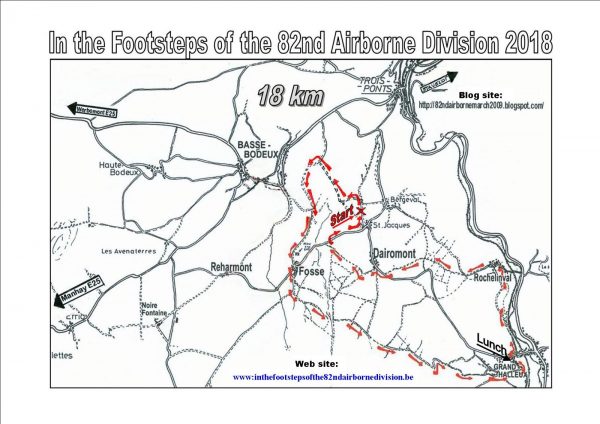 On December 16, 1944, the Germans launched a surprise offensive through the Ardennes Forest which caught the Allies completely by surprise. Two days later the 82nd joined the fighting and quickly blunted General Von Runstedt’s northern penetration of the American lines.
On December 16, 1944, the Germans launched a surprise offensive through the Ardennes Forest which caught the Allies completely by surprise. Two days later the 82nd joined the fighting and quickly blunted General Von Runstedt’s northern penetration of the American lines.
Despite a lack of cold weather equipment once again airborne spirit, courage, and hard-nosed determination won the day as the 505th withstood the bleak winter and stopped the fanatic German attacks at St. Vith and the Salm River.
By the end of the war, the 505th was awarded three foreign distinguished unit citations: the French fourragère, the Netherlands Military Order of William, and the Belgium fourragère.
 GOYA– Stands for ‘Great Outstanding Young Americans’ but there are other translations of GOYA known by the troopers themselves. The 551 PIB was activated in 1942 with 800 men and deactivated in 1945 when just 110 surviving men were absorbed into the 82nd Airborne Division. On 3 January 1945, the Battalion’s Co A, under the command of Lt Durkee, launched one of the two bayonet charges performed by the US troops during the Battle of the Bulge.
GOYA– Stands for ‘Great Outstanding Young Americans’ but there are other translations of GOYA known by the troopers themselves. The 551 PIB was activated in 1942 with 800 men and deactivated in 1945 when just 110 surviving men were absorbed into the 82nd Airborne Division. On 3 January 1945, the Battalion’s Co A, under the command of Lt Durkee, launched one of the two bayonet charges performed by the US troops during the Battle of the Bulge. 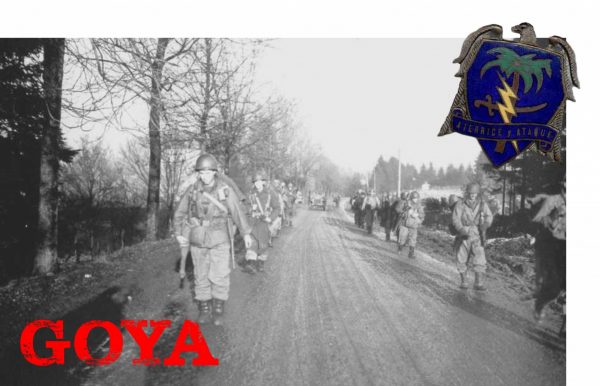 While victorious in capturing Rochelinval and eliminating the last German bridgehead for over 10 miles (16 km) on the Salm River, the unit was virtually decimated, having suffered more than 85% casualties. Relieved on 9 January 1945, of the 643 men who entered the battle on 3 January, only 14 Officers and 96 men remained. “Nowhere were casualties higher than in Lt Col Wood Joerg’s (KIA in Rochelinval), 551st ‘LOST’ Battalion.”
While victorious in capturing Rochelinval and eliminating the last German bridgehead for over 10 miles (16 km) on the Salm River, the unit was virtually decimated, having suffered more than 85% casualties. Relieved on 9 January 1945, of the 643 men who entered the battle on 3 January, only 14 Officers and 96 men remained. “Nowhere were casualties higher than in Lt Col Wood Joerg’s (KIA in Rochelinval), 551st ‘LOST’ Battalion.”
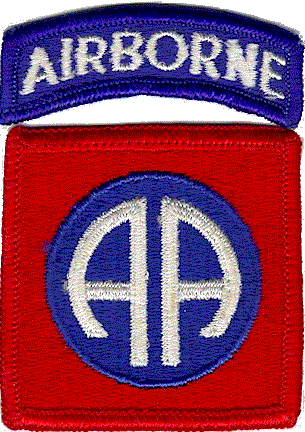
The post 82 Airborne Division Walk 2018 appeared first on World War Media.
]]>The post Help WWII Daughter To Walk The Steps Of Her Father appeared first on World War Media.
]]>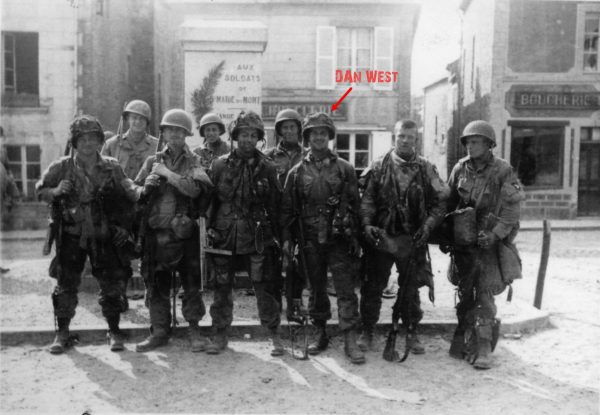
Ste-Marie-du-Mont, Normandy
 DB jumped into Normandy from LT Bob Matthews Stick #71 and landed somewhere between St. Mere Eglise and Ravenoville. He methodically made his way to Marmion Farm and took part in the fighting to seize the small hamlet from German forces. After a couple of days, DB made his way towards Causeway #2 and during that time passed through St. Marie du Mont, where he took part in the iconic photo that adorns the front cover of Stephen Amborse’s best-selling book, Band of Brothers.
DB jumped into Normandy from LT Bob Matthews Stick #71 and landed somewhere between St. Mere Eglise and Ravenoville. He methodically made his way to Marmion Farm and took part in the fighting to seize the small hamlet from German forces. After a couple of days, DB made his way towards Causeway #2 and during that time passed through St. Marie du Mont, where he took part in the iconic photo that adorns the front cover of Stephen Amborse’s best-selling book, Band of Brothers.
At the conclusion of the Normandy campaign, he returned to England with the rest of Easy and prepared for their next mission, Operation Market-Garden. DB jumped into Holland with the rest of Easy and endured the 70+ days of miserable conditions and incessant and nerve-racking outpost duty while on the Island. After recovering from that campaign, West, along with his Easy Company buddies, took part in the epic defense of Bastogne. He was also part of the Rhineland Campaign and like many others in Easy, enjoyed the sweet taste of victory at Berchtesgaden and the Eagle’s Nest. A high point man, he returned home to restart a life that had been interrupted by the war.
In Her Father’s Footsteps
Mrs. Landis lives on a modest income which has been severely impacted by the rising costs of medical bills. As a result, it would be nearly impossible for her to pay for a trip to Europe to walk the fields of battle where her father and his Band of Brothers served so gallantly.
Due to the efforts of GBC Tours, Cathy will have a chance to travel across Europe in September 2018, provided we can raise $6000.00 to cover airfare, ground transport, lodging and meals. Please help to provide Cathy with some closure. Help her finally stand in the places where her father fought. This is noble cause that will support a family that has given so much to the Nation and Europe.
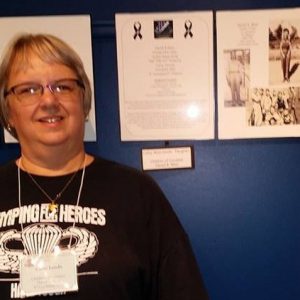
Cathy (West) Landis
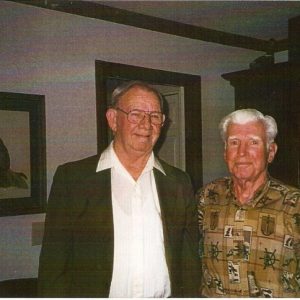
Dan West and Carwood Lipton
The post Help WWII Daughter To Walk The Steps Of Her Father appeared first on World War Media.
]]>The post Band of Brothers Lost Another Hero- Donald G Malarkey appeared first on World War Media.
]]>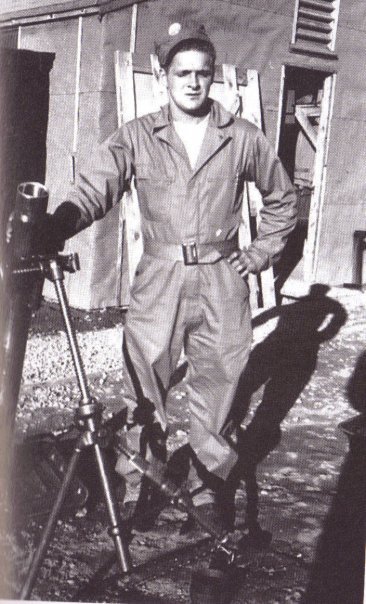
Today we received the sad news that another WWII hero has made his final Jump. Sgt T/4 Donald G Malarkey (96) has been an example and an unfailing source of inspiration to many of us.
Born in Astoria, Oregon on 21 July 1921, Donald Malarkey was drafted into the United States Army in 1942 where he volunteered to join the paratroopers in training at Camp Toccoa, Georgia.
Assigned to the 101st Airborne Division, he became a member Company E (Easy) of the 506 Parachute Infantry Regiment. With this unit Malarkey parachuted into Normandy, France on 6 June 1944 as part of ‘Operation Overlord’, D-Day. He was part of the crew to take out four German guns in the field at Brécourt Manor.
Promoted to sergeant, he joined his mortar squad in Operation Market-Garden and the Battle of the Bulge and was awarded with the Bronze Star, Purple Heart, Good Conduct Medal, American Campaign Medal
Donald Malarkey’s rifle company became the subject of historian Stephen E. Ambrose’s 1992 non-fiction book ‘Band of Brothers’ which was turned in a successful mini-series in 2001 by HBO . Don’s character was portrayed by actor Scott Richard Grimes.
To learn more about Sergeant Malarkey’s time in WWII, we highly recommend his book: Easy Company Soldier: The Legendary Battles of a Sergeant from World War II’s “Band of Brothers” by Don Malarkey and Bob Welch.
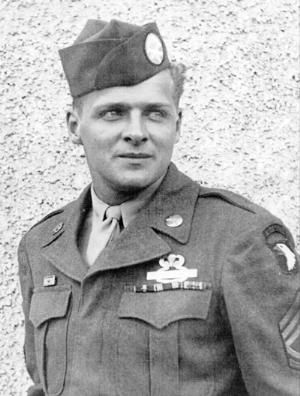
The post Band of Brothers Lost Another Hero- Donald G Malarkey appeared first on World War Media.
]]>The post Tigers In The Ardennes: The 501st Heavy SS Tank Battalion in the Battle of the Bulge appeared first on World War Media.
]]>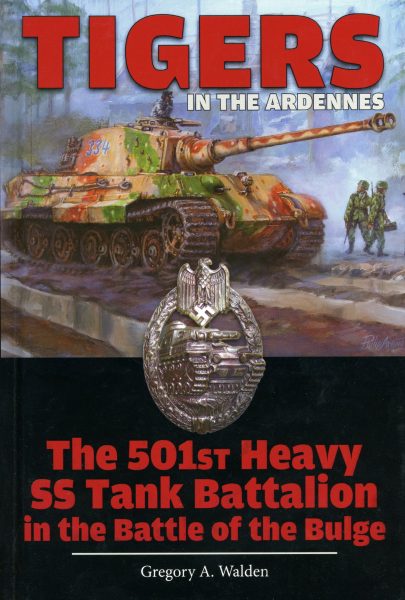
U.S. Army officer and military historian Gregory Walden provides the most detailed look at the actions of a single German battalion in the Battle of the Bulge to date. Tigers in the Ardennes is the product of years of research in archives, conversations with German and American veterans, and detailed examination of terrain in the Ardennes battlefields. The author’s experience as a tank unit commander provides unique insight into the tactical difficulties of armor movements through the Ardennes, especially considering the technical aspects of the Tiger II tanks. The book includes over 100 images, including photographs of the Tiger II tanks never before published, plus detailed maps showing the routes used by the 501st Heavy SS Tank Battalion during the battle.
Tigers in the Ardennes shows the human side of tank warfare, focusing on one German unit – how the men and their unit prepared for the battle, what they experienced (often in their own words, from interviews with veterans), how they used their powerful tanks, and the shortcomings of those tanks which eventually kept them from accomplishing their objective. The author, Gregory Walden, is a retired U.S. Army officer, with 20 years’ experience in tanks and armored units. As a tank commander and armor unit leader, the author’s perspective lends a better understanding of how the men felt as they pushed forward in the offensive, how they used their tanks to tactical advantage, and the reasons why their equipment ultimately failed them.
In addition to the stories of the soldiers who manned the tanks, the book gives detailed descriptions of the Tiger tanks. This information is presented in a listing of the tanks which took part in the battle, including names of their crews where known, their camouflage paint and other physical characteristics, and a description of what happened to the tanks during the battle. The descriptions are supported by numerous photographs and film stills taken during and after the battle. The detailed descriptions will be of interest to military historians of the Battle of the Bulge, those interested in the Tiger II tank in general, and military modelers.
As an amateur historian interested in the German armored forces of World War II, the author visited the Ardennes battlefields many times, and interviewed numerous veterans of the Battle of the Bulge. He also conducted research with Belgian historians, and in the U.S. National Archives and the German Bundesarchiv. The book includes over 100 images, including photographs of the Tiger II tanks never before published, plus detailed maps showing the routes used by the 501st Heavy SS Tank Battalion during the battle.
About The Author:
Gregory Walden is a retired U.S. Army officer and military historian. His book, Tigers in the Ardennes: The 501st Heavy SS Tank Battalion in the Battle of the Bulge, was published by Schiffer Publishing. The author’s experience as a tank unit commander provides unique insight into the tactical difficulties of armor movements through the Ardennes forest region of Belgium. A 20 year Army veteran, Greg served in Armor branch, and spent most of his service time in Cavalry units. He spent three tours of duty in Germany during the Cold War. While there he visited the Ardennes area many times to study the battle sites and meet with veterans and local historians. Greg is a member of the Company of Military Historians and of the Association of 3rd Armored Division Veterans, and lives in Florida with his wife, Susan; sons Rob and Alex; and two puppies.
ORDER YOUR COPY
Book data:
Hardcover: 144 pages
Publisher: Schiffer Military History
ISBN-10: 076434790X
ISBN-13: 978-0764347900
The post Tigers In The Ardennes: The 501st Heavy SS Tank Battalion in the Battle of the Bulge appeared first on World War Media.
]]>The post Lost WWI Submarine Discovered Near Belgian Coast appeared first on World War Media.
]]>Found somewhere between 82-98 feet under the surface, the boat is reportedly 88 feet long and nearly 20 feet wide. WWI U-boats were commonly staffed by a crew of 23 and, given the ship’s preserved condition, officials believe it’s likely the crew is still inside.
In an interview with LiveScience, marine archaeologist Tomas Termote, one of the divers who discovered the ship, said sonar scans first picked up presence of a large, wrecked object on the seafloor in 2014. He initially thought the wreckage came from the remains of a World War II landing craft, which have been frequently found in the area.
Video taken of the wreckage shows the top of the ship’s remains. In the hundred years since it sank, barnacles and algae have since grown over the structure.
It’s the 11th such sunken German ship to have been discovered in the region and reportedly in the best condition. The submarine was a UB-II type of U-boat, a formidable weapon of war in their heyday. Equipped with torpedoes, UB-IIs were frequently stationed in the North Sea and unleashed significant damage on allied forces.
The post Lost WWI Submarine Discovered Near Belgian Coast appeared first on World War Media.
]]>The post He Is Not Missing, He Is Here appeared first on World War Media.
]]>by Jo Segers
The Menin Gate was the first Memorial to the Missing erected after the First World War by the then Imperial (now Commonwealth) War Graves Commission. The memorial bears the names of more than 54,000 officers and men who died in the Ypres Salient during the First World War and whose graves are not known. It also honours all those who served there, bearing an inscription devised by writer Rudyard Kipling, who was the first Literary Advisor to the Commission:
To the armies of the British Empire who stood here from 1914 to 1918 and to those of their dead who have no known grave.
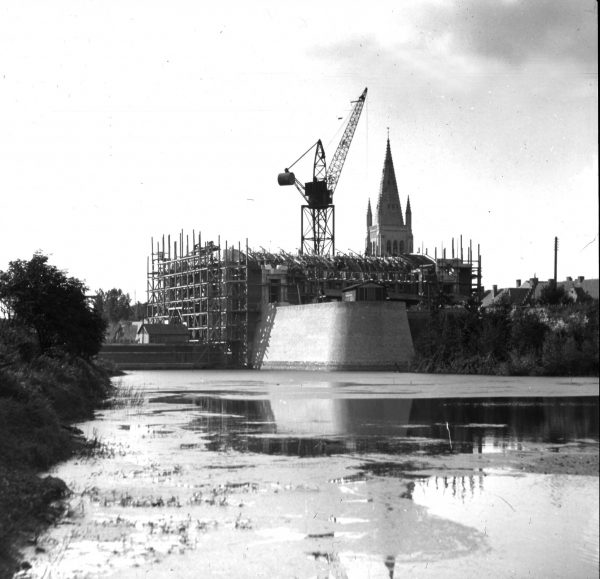
Courtesy of CWGC
Speaking about the memorial, the CWGC’s Director General, Mrs Victoria Wallace said: “The Menin Gate has been the focus of pilgrimage for thousands for 90 years. The first great memorial to the missing, it is an extraordinarily special place of commemoration, and its significance has been enhanced by the devotions of the people of Ypres, who hold their daily Last Post event under its arches every evening. It is hugely gratifying to see so many young people visiting the Gate, ensuring that the names of the missing live forever.”
The memorial was designed by Sir Reginald Blomfield with sculpture by Sir William Reid-Dick, and was unveiled by King Albert I of Belgium and Field Marshal Lord Plumer on 24 July 1927 in the presence of thousands of veterans and family members. Crowds lined the ramparts and the streets, and loudspeakers relayed the events to the market square. The unveiling was also broadcast by the BBC.
At the end of the ceremony buglers of the Somerset Light Infantry sounded the Last Post and pipers of the Scots Guards played a lament.
Soon afterwards, the act of sounding the Last Post became a daily ritual, led by the local fire brigade. It has been sounded under the arch every night at 8pm almost every day since, except during the Second World War when Belgium was again occupied. Today organised by the Last Post Association, the ceremony is often attended by thousands who have come to pay their respects.
The site of the Menin Gate was chosen because of the hundreds of thousands of men who passed through it on their way to the battlefields. It commemorates casualties from the forces of Australia, Canada, India, South Africa and the United Kingdom.
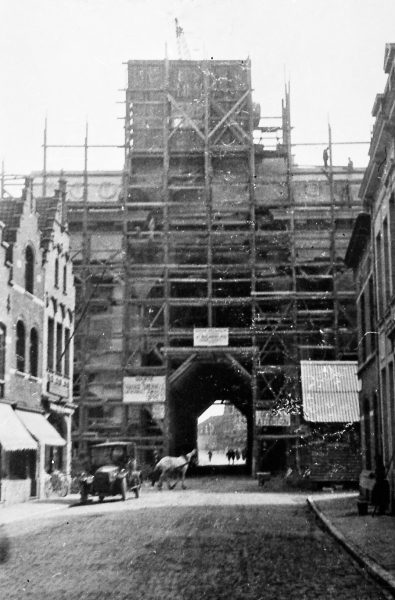
Image from the Goodland- KIngs Pilgrimage collection scanned and enhanced from negatives by Chris Lofty
In his speech at the unveiling, Lord Plumer said: “It was resolved that here at Ypres, where so many of the ‘Missing’ are known to have fallen, there should be erected a memorial worthy of them which should give expression to the nation’s gratitude for their sacrifice and its sympathy with those who mourned them. A memorial has been erected which, in its simple grandeur, fulfils this object, and now it can be said of each one in whose honour we are assembled here today: ‘He is not missing; he is here’.”
To mark both the CWGC’s Centenary and the 90th anniversary of the Menin Gate, a photographic exhibition will open on the Ramparts next to the Menin Gate on 24 July. The exhibition features images from the CWGC’s archive and gives a fascinating insight into the care of this much loved monument and the many CWGC war cemeteries in Flanders. The exhibition will run until the end of September 2017.
The history
From October 1914 to October 1918, five major battles occurred at Ypres (now Ieper) in Belgium. The area saw some of the heaviest fighting in the First World War leaving Ypres in ruins. By the time the last shells fell in Belgium in November 1918, the fighting had claimed 193,000 Commonwealth lives – more than half of these men have no known grave.
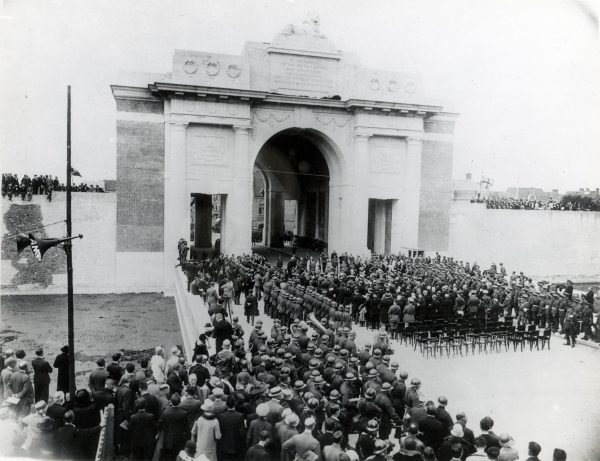
Courtesy of CWGC
As hundreds of thousands of Commonwealth troops had passed through the city on their way to the battlefields, it was decided that Ypres was where the missing should be commemorated. Within the city of Ypres, different options were considered. Moderating Sir Winston Churchill’s suggestion to claim the entire city as a memorial, the Belgian government agreed to make available a section of the ramparts, incorporating the ruins of the old Menin Gate, where a fitting memorial might be built.
“I should like to acquire the whole of the ruins of Ypres… A more sacred place for the British race does not exist in the world,” Sir Winston Churchill, 1919.
The design
Sir Reginald Blomfield, one of the Commission’s first three Principal Architects, was appointed to design the memorial.
He sought to design a monument based around the concept of a triumphal arch and a central hall. He drew inspiration from the seventeenth century Porte de la Citadelle in Nancy, France, a structure he admired.
The memorial is built of reinforced concrete faced with Euville stone and red brick. Its design is neo-classical and features symbols such as a lion, wreaths and garlands.
The lions atop the memorial are the work of Scottish sculptor Sir William Reid Dick. It is the symbol of Britain, but also the lion of Flanders. The sculptor had a distinguished career in the military, serving with the Royal Engineers in France and Palestine. It was while he was in the trenches that he began carving.
The central hall is dominated by the name panels of the missing which run along the entire length of the interior. There are 60 panels, arranged by regiment and in order of rank in alphabetical order.
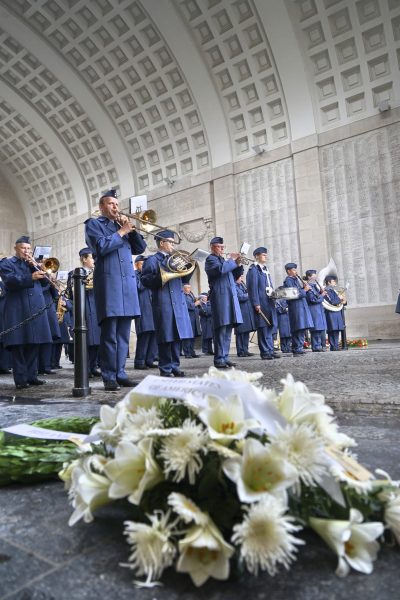
Courtesy of Jo Segers
Today, the memorial bears the names of more than 54,000 men of the forces of Australia, Canada, India, South Africa and United Kingdom who died in the Ypres Salient and who have no known grave. The New Zealand government decided that the names of its missing should be commemorated in cemeteries near to where they died.
(All images are courtesy of Jo Segers, CWGC and the Goodland- Kings Pilgrimage collection scanned and enhanced from negatives by Chris Lofty)
The post He Is Not Missing, He Is Here appeared first on World War Media.
]]>The post Dunkirk From The Air appeared first on World War Media.
]]>By May 26 1940, around 250,000 British troops, the rump of what remained of the British Expeditionary Force (BEF), were surrounded in the French port of Dunkirk and being mercilessly attacked by Göring’s Stuka dive-bombers. From the air it seemed that the nearby beaches swarmed with a huge army of ants that rippled with fear as German pilots made strafing runs.
By Alex Kershaw, author of The Bedford Boys, The Longest Winter, Avenue of Spies, The Liberator.
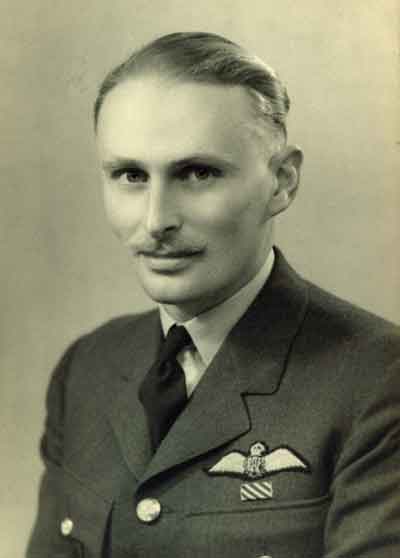
Flight Lieutenant Frank Howell, RAF 609 Squadron.
The mood was grim, both on the sand dunes where starving, exhausted Tommies waited for rescue, and in London, where even in Churchill’s War Cabinet there was talk of a compromise peace with Hitler. Churchill ended all such defeatist sentiment, telling his cabinet in an emotionally charged meeting on May 28: “I am convinced that every one of you would rise up and tear me down from my place if I were for one moment to contemplate parley or surrender. If this long island story of ours is to come to an end at last, let it end only when each of us lies choking in his own blood upon the ground.”
Churchill’s defiance was met with cheers and hurrahs. It was clear that he now had every one of his cabinet firmly on his side. “Quite a number,” he recalled, “seemed to jump from the table and come running to my chair, shouting and patting me on the back . . . had I at this juncture faltered at all in leading the nation I should have been hurled out of office. I am sure that every Minister was ready to be killed quite soon, and have all his family and possessions destroyed, rather than give in.”
Just as the cabinet had rallied to Churchill, so would the nation. But first, something had to be salvaged from the disaster unfolding at Dunkirk. Senior commanders hoped that perhaps thirty thousand men, a fraction of the British Expeditionary Force, might be saved. In London, Ambassador Kennedy added his own assessment to the general air of doom, cabling President Roosevelt that: “Only a miracle can save the BEF from being wiped out or, as I said yesterday, surrender . . . the English people, while they suspect a terrible situation, really do not realize how bad it is. When they do I don’t know what group they will follow, the do or die or the group that wants a settlement.”
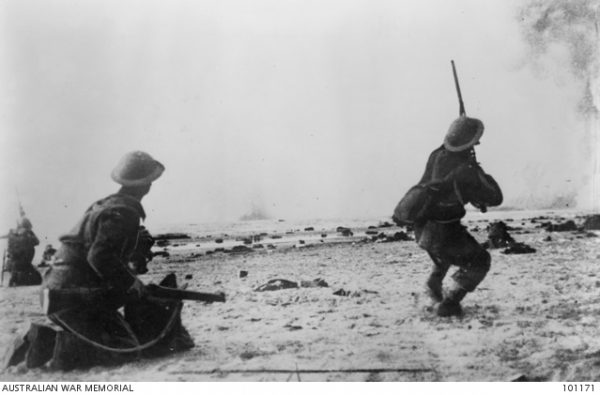
But all was not yet lost. The seafaring nation was beginning to respond to a call for all available vessels to make the hazardous Channel crossing and evacuate men from the bloodstained beaches. All manner of craft, from private dinghies to Thames tugboats, were headed toward Dunkirk. Above the beaches, Fighter Command’s Spitfire and Hurricane squadrons were also now in action, fighting with unprecedented aggression, many of their pilots furious at the sight of their countrymen being mowed down as they waded in long snaking lines toward rescue boats. Even veteran Luftwaffe pilots, who had readily strafed columns of refugees in Spain and destroyed Guernica, soon began to sicken of the slaughter. For twenty-four-year-old Captain Paul Temme, flying at three hundred feet above his victims, it was “just unadulterated killing. The beaches were jammed full of soldiers. I went up and down ‘hose-piping.’ It was cold-blooded point-blank murder.”
The fighting over Dunkirk would be a prelude to the Battle of Britain, and the Luftwaffe and the RAF took careful measure of each other. For the first time, the Germans encountered the full force of Fighter Command, and it was soon clear that the RAF’s Spitfires and Hurricanes were just as lethal as the Messerschmitt Me-109, the Germans’ best fighter. Another thing was quickly obvious: the British pilots were as well disciplined and courageous as their foe in the air, confirming the warning of influential First World War veteran Theo Osterkamp: “Now we fight ‘The Lords,’ and that is something else again. They are hard fighters and they are good fighters.”
For many RAF pilots, Dunkirk was a chaotic and brutal baptism of fire. “The Me-109s were quicksilver,” recalled one squadron leader. “It would have been ideal to come against them as a controlled formation, but the Germans always split up, so somehow you did, too. Then it was every man for himself—which was all right if you were good.” Thankfully, some were very good indeed. They included twenty-eight-year-old Flight Lieutenant Frank Howell of 609 West Riding Squadron, a strikingly handsome, blond-haired former mechanic who, on June 1, 1940, was appointed a flight leader after two days of fierce combat.
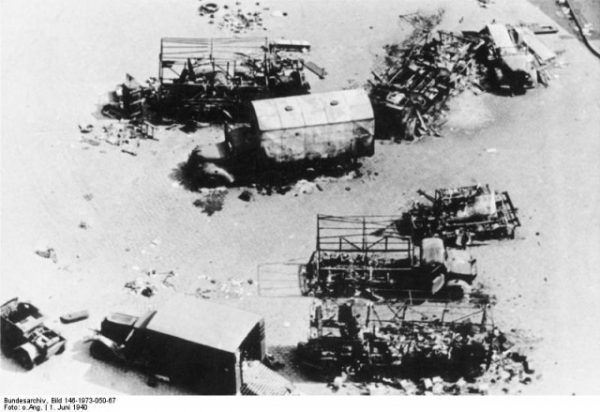
In a remarkable letter to his brother, Howell provided a vivid account of what it was like to fly above the hell of Dunkirk: “The place was still burning furiously, a great pall of smoke stretching 7,000 feet in the sky over Belgium . . Thousands and thousands of A/A [anti-aircraft] shells were bursting over the town . . . I looked down to see salvo after salvo of bombs bursting with terrific splashes in the water near some shipping, and there was a Heinkel, only 500 feet below going in the opposite direction so I did a half roll, and came up its arse, giving it a pretty 2 seconds fire . . . All the way back to England I flew full throttle at about 15 feet above the water and the shipping between England and Dunkirk was a sight worth seeing. Paddle boats, destroyers, sloops, tugs, fishing trawlers, river launches . . . anything with a motor towing anything without one . . . I am indeed lucky to have got away scot free. Dizzy was killed and five other chaps are missing. One was my flight commander so I am now in charge of A Flight, and will get another stripe, and it’s a rotten way to get it.”
On June 1, Winston Churchill was back in Paris, again trying to rally the French and sharing with them the heartening news that more than 165,000 troops had been pulled off the beaches at Dunkirk. Distressingly, his exhortations to fight on to the very end appeared to fall on deaf ears. Churchill’s escort from Paris back to England was to be provided by 601 Squadron, otherwise known as the Millionaires’ Squadron because several of its pilots came from wealthy families. “Winston was ebullient as ever,” recalled an aide. “When we started back he insisted on pacing round the aerodrome to review [601’s] nine Hurricanes, tramping through the tall grass in the flurry of propellers with his cigar like a pennant.”
British Major General Sir Edward Spears remembered “nine fighter planes drawn up in a wide semi-circle around the Prime Minister’s Flamingo . . . Churchill walked toward the machines, grinning, waving his stick, saying a word or two to each pilot as he went from one to the other, and, as I watched their faces light up and smile in answer to his, I thought they looked like the angels of my childhood. These men may have been naturally handsome, but that morning they were far more than that, creatures of an essence that was not of our world: their expressions of happy confidence as they got ready to ascend into their element, the sky, left me inspired, awed and earthbound.”
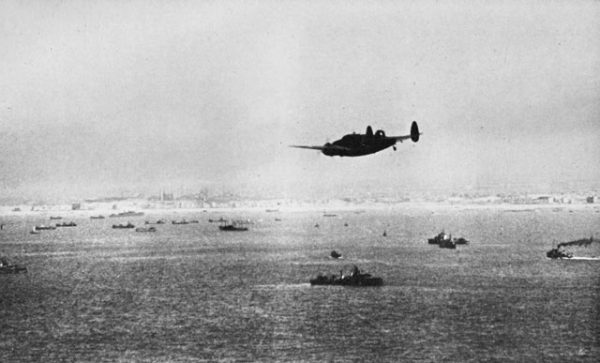
One of these angels, Flying Officer Gordon “Mouse” Cleaver, remembered that morning somewhat differently.13 The night before, the Millionaires had become rip-roaring drunk: “There assembled at Villacou-blay just about as hungover a crew of dirty, smelly, unshaven, unwashed fighter pilots as I doubt has ever been seen. Willie [Rhodes-Moorehouse] if I remember right was being sick behind his aeroplane, when the Great Man arrived and expressed a desire to meet the escort. We must have appeared vaguely human at least, as he seemed to accept our appearance without comment, and we took off for England.”14 By June 4, the evacuation of Dunkirk was officially over with an incredible 338,226 Allied troops removed from the beaches to England. Göring’s promise that “not a British soldier will escape” had been ludicrous. He had simply been “talking big again” as General Alfred Jodl, Chief of Hitler’s General Staff, was quick to point out.15 In a week of almost constant combat above Dunkirk, the RAF had shot down 132 German planes for a loss of 99 of its own fighters, 5 from Flight Leader Frank Howell’s 609 Squadron. It was a remarkable performance, or as Churchill described it to his War Cabinet, “a signal victory which gives cause for high hopes of our successes in the future.”
The British Expeditionary Force had been saved by some 693 boats of all sizes, many of them “little ships”—dinghies, pleasure yachts, skiffs, tugboats—a quarter of which were sunk. But now it had nothing to fight with. Almost all the BEF’s armor and weapons had been left behind, leaving England practically defenseless. The evacuation of Dunkirk could certainly not be described as a victory, but it was nevertheless a powerful tonic to both the British people and the rest of the free world.
The post Dunkirk From The Air appeared first on World War Media.
]]>The post The Life And Career Of Gustav Knittel -by Timo Worst appeared first on World War Media.
]]>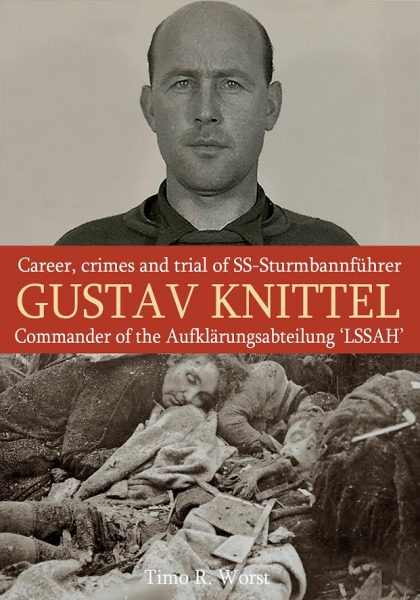
Displeased by previous published content about the SS in Stavelot and the surrounding hamlets, Worst felt compelled to visit the Ardennes himself, to search the archives and ultimately to contact veterans of Knittel’s battalion and to consult his family. By providing the available pieces of the puzzle, the author allows the reader to follow Knittel’s footsteps: his entry in the SS, the units he led traversing Europe from France and Greece to Italy, Ukraine and Belgium, the men under his command, the battles he fought and awards he won, but also his doubts about the outcome of the war and how this effected his state of mind, the massacres, his arrest, the trial and his post-war life.
This book enables the reader to see through the multiple layers of smoke created not only by Knittel, his defending lawyers or his wartime comrades, but also by his captors, his interrogators and the prosecutors.
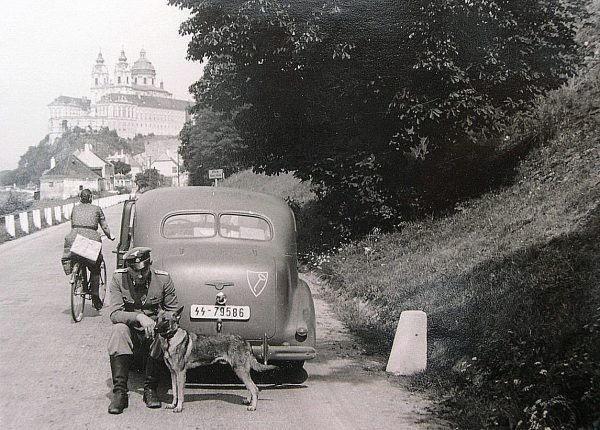
Photo Courtesy of Timo Worst
Review by Danny S Parker, author of Fatal Crossroads and Hitler’s Warrior
In this new biography of Waffen-SS officer Gustav Knittel, Timo Worst documents the life of a man who would become the head of the reconnaissance battalion of the 1st SS Panzer Division in Hitler’s Third Reich. Knittel’s life mirrors the prospects and war path of other officers in the Leibstandarte Adolf Hitler – a formation which developed an infamous reputation for brutality and war crimes in the Second World War.
How did this state of affairs come to be? Worst gives us many details which amount to a war-time mosaic of what it meant to be an SS officer in Hitler’s most favoured combat formation. With Knittel’s life as a central pivot, we gain new insight into the savage actions in which his reconnaissance battalion became engaged, both on the Eastern Front and in the West. It is then hardly surprising that as the combat heir to Kurt Meyer, Knittel’s command developed a savage reputation.
Nor did the affair end with the war. As we learn about the post war Malmédy trial and how Knittel and the others under him successfully campaigned to escape the hangman at Landsberg prison. Ultimately they were released into a Germany that bore little resemblance to the one for which they had fought from 1939-45.
While SS officers such as Peiper, Meyer and Mohnke have previously been covered in recent literature this is a new contribution with revealing details and revelations regarding Gustav Knittel. Recommended.
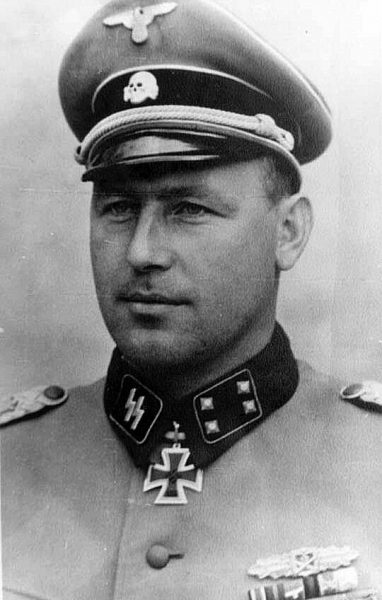
Photo Courtesy of Timo Worst
Review by Marc Rikmenspoel, author of Waffen-SS Encyclopedia
What this book really does is show that the rotten core of the SS spread to every facet of the organization. Knittel served alongside men who had important roles in crimes against humanity. Waffen-SS veteran publications only portray these men during their time as frontline soldiers, but Timo gives the full story. The picture of the Leibstandarte isn’t really a pretty one, but it is a good contrast to the HiAG version of its history.
The book is full of personal accounts by veterans. These show the reality of Eastern Front combat, in all its horror and brutality. They also demonstrate that by the time of the Normandy fighting, the Germans didn’t really stand a chance. The soldiers couldn’t openly admit that the war was lost, and the frustrations they felt were vented in a terrible way in the Stavelot area during December 1944.
I highly recommend it to anyone interested the Waffen-SS, the Eastern Front, and the Battle of the Bulge.
The post The Life And Career Of Gustav Knittel -by Timo Worst appeared first on World War Media.
]]>The post General Anthony C McAuliffe 1945 and 1948 Broadcasts appeared first on World War Media.
]]>By Reg Jans – With special thanks to Mr. Kenneth McAuliffe, Mr. Joe Beyrle II and Mr. Paul Clifford
With a good sense of humor, the former acting commander of the 101st Airborne Division entertains the audience and talks about his experiences in Bastogne during th Battle of the Bulge.
Shortly before taking command of the 103 Infantry Division, in January 1945, the now legendary General talks about the Battle for Bastogne. (low quality)
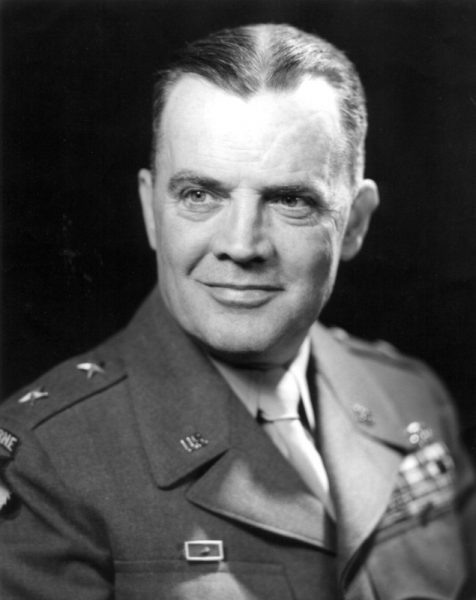
The post General Anthony C McAuliffe 1945 and 1948 Broadcasts appeared first on World War Media.
]]>The post D-Day Historian: A James Bond Story appeared first on World War Media.
]]>Ian Lancaster Fleming (28 May 1908 – 12 August 1964) was an English author, journalist and naval intelligence officer who is best known for his James Bond series of spy novels. Fleming came from a wealthy family connected to the merchant bank Robert Fleming & Co., and his father was the Member of Parliament for Henley from 1910 until his death on the Western Front in 1917. Educated at Eton, Sandhurst and, briefly, the universities of Munich and Geneva, Fleming moved through several jobs before he started writing.
While working for Britain’s Naval Intelligence Division during the Second World War, Fleming was involved in planning Operation Goldeneye and in the planning and oversight of two intelligence units, 30 Assault Unit and T-Force. His wartime service and his career as a journalist provided much of the background, detail and depth of the James Bond novels.
Fleming wrote his first Bond novel, Casino Royale, in 1952. It was a success, with three print runs being commissioned to cope with the demand. Eleven Bond novels and two collections of short-stories followed between 1953 and 1966. The novels revolved around James Bond, an officer in the Secret Intelligence Service, commonly known as MI6. Bond was also known by his code number, 007, and was a commander in the Royal Naval Reserve.
Paul Woodadge is a British born battlefield guide and historian living in Normandy, France. He is a published author and in addition to working as a DDay and Battle of Normandy tour guide he works as a historical consultant and advisor on WWII documentaries, films and TV shows. He is highly regarded as one of the foremost experts on 1944 and the invasion of Europe by the Allies and has met countless veterans.
The post D-Day Historian: A James Bond Story appeared first on World War Media.
]]>The post D-Day Historian: Carwood Lipton in Normandy appeared first on World War Media.
]]>First Lieutenant Clifford Carwood Lipton (30 January 1920 – 16 December 2001) was a commissioned officer with Easy Company, 2nd Battalion, 506th Parachute Infantry Regiment, in the 101st Airborne Division during World War II. Lipton was portrayed by Donnie Wahlberg in the HBO miniseries Band of Brothers. On the battlefields of Europe, he was promoted to Company First Sergeant and ultimately was awarded a battlefield commission to Second Lieutenant. He said “it was the greatest honor ever awarded” to him. He eventually earned a promotion to First Lieutenant before leaving the Army.
Paul Woodadge is a British born battlefield guide and historian living in Normandy, France. He is a published author and in addition to working as a DDay and Battle of Normandy tour guide he works as a historical consultant and advisor on WWII documentaries, films and TV shows. He is highly regarded as one of the foremost experts on 1944 and the invasion of Europe by the Allies and has met countless veterans.
The post D-Day Historian: Carwood Lipton in Normandy appeared first on World War Media.
]]>The post Honoring D-Day Veterans appeared first on World War Media.
]]>
Arromanches-les-Bains
Arromanches is remembered as a historic place of the Normandy landings and in particular as the place where an artificial port was installed. This artificial port allowed the disembarkation of 9,000 tons of material per day.
It was on the beach of Arromanches that, during the Invasion of Normandy immediately after D-Day, the Allies established an artificial temporary harbour to allow the unloading of heavy equipment without waiting for the conquest of deep water ports such as Le Havre or Cherbourg. Although at the centre of the Gold Beach landing zone, Arromanches was spared the brunt of the fighting on D-Day so the installation and operation of the port could proceed as quickly as possible without damaging the beach and destroying surrounding lines of communication. The port was commissioned on 14 June 1944.
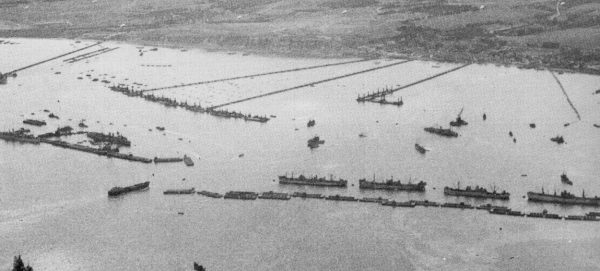
This location was one of two sites chosen to establish the necessary port facilities to unload quantities of supplies and troops needed for the invasion during June 1944, the other was built further West at Omaha Beach. The British built huge floating concrete caissons which, after being towed from England, then had to be assembled to form walls and piers forming and defining the artificial port called the Mulberry harbour. These comprised pontoons linked to the land by floating roadways. One of these ports was assembled at Arromanches and even today sections of the Mulberry harbour still remain with huge concrete blocks sitting on the sand and more can be seen further out at sea.
Some key figures: by 12 June 1944 more than 300,000 men, 54,000 vehicles, 104,000 tons of supplies had been landed. During 100 days of operation of the port 2.5 million men, 500,000 vehicles, and 4 million tons of material were landed. The best performance of the port was in the last week of July 1944: during those seven days the traffic through Arromanches exceeded 136,000 tons or 20,000 tons per day.
The post Honoring D-Day Veterans appeared first on World War Media.
]]>The post Historian Alex Kershaw Talks About the Most Decorated Platoon in WWII appeared first on World War Media.
]]>
Vastly outnumbered, they repulsed three German assaults in a fierce day-long battle, killing over 64 German Fallschirmjaeger and wounding another 100, defending a strategically vital hill. Only when Bouck’s men had run out of ammunition did they surrender to the enemy. As POWs, Bouck’s platoon began an ordeal far worse than combat-survive in captivity under trigger-happy German guards, Allied bombing raids, and a daily ration of only thin soup. In German POW camps, hundreds of captured Americans were either killed or died of disease, and most lost all hope. But the men of Bouck’s platoon survived-miraculously, all of them. Once again in vivid, dramatic prose, Alex Kershaw brings to life the story of some of America’s little-known heroes-the story of America’s most decorated small unit, an epic story of courage and survival in World War II, and one of the most inspiring stories in American history.
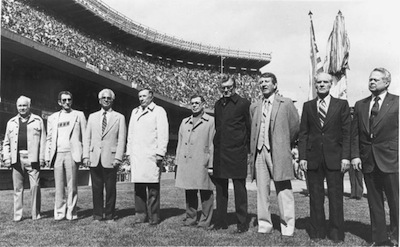
The I&R Platoon’s first reunion
In this short video, historian and author Alex Kershaw returns to Lanzerath, Belgium and talks about the I&R Platoon.
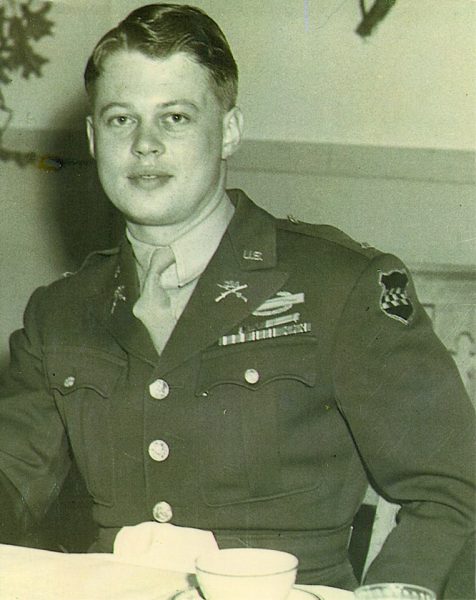
The post Historian Alex Kershaw Talks About the Most Decorated Platoon in WWII appeared first on World War Media.
]]>The post The Modified M3 Grease Gun in WWII appeared first on World War Media.
]]>The .45 caliber submachine gun M3 is often indicated as being a success story of small arms design and development during World War II. Born of the necessities and exigencies of a full national wartime mobilization, it is best known for the economy of scale it provided and the modesty of its manufacturing costs.
by Martin K A Morgan
At peak production, M3s were a bargain at $20.94 each – that’s less than half the cost of the cheaper, mass-production version of the Thompson submachine gun. Although low cost was a major factor in the M3’s success, so too was the speed of its development and adoption. The project went from a concept on paper, to the T20 prototype, to adoption and production within just seven months, a record that no other firearm in U.S. military history has ever challenged. When it went into production in May 1943 at GM’s Guide Lamp Division plant in Anderson, Indiana, the M3 was a reliable open-bolt submachine gun weighing just over eight pounds with a fully loaded 30-round detachable box magazine. It’s design made extensive use of sheet metal stampings to include the two halves of the receiver assembly, the trigger, the rear sight, and a crank handle on the right side of the gun used to retract the bolt before firing. The M3’s sheet metal construction made it lighter and cheaper to produce, and gave it an appearance resembling an auto mechanics grease gun. But sheet stampings also created one weakness that would soon reveal itself on the battlefield.
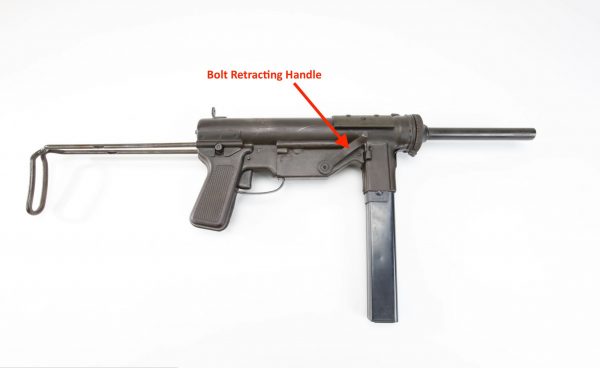
A right side view of M3 submachine gun #0061260 – an early pattern Grease Gun produced at GM’s Guide Lamp Division plant in Anderson, Indiana in 1943. The red arrow shows the delicate bolt retracting “crank handle” that created the need for a field modification. (Photo courtesy of the National Firearms Museum)
On Tuesday, June 6, 1944, U.S. troops used the M3 Grease Gun in action for the first time. During the weeks that followed, it fought a vigorous campaign stretching from Normandy through to the liberation of Paris and the push to the Siegfried Line. Soldiers carried it up hill and down valley through the adversity of dust, rain and, eventually, even the snow. They were beat-up as the troops climbed on and off of trucks, half-tracks, and tanks. While an M3 could survive being dropped on its left side without affecting its ability to function, dropping one on its right side was another matter entirely because that is where the weapon’s fragile sheet metal retracting handle was mounted to the trigger housing assembly.
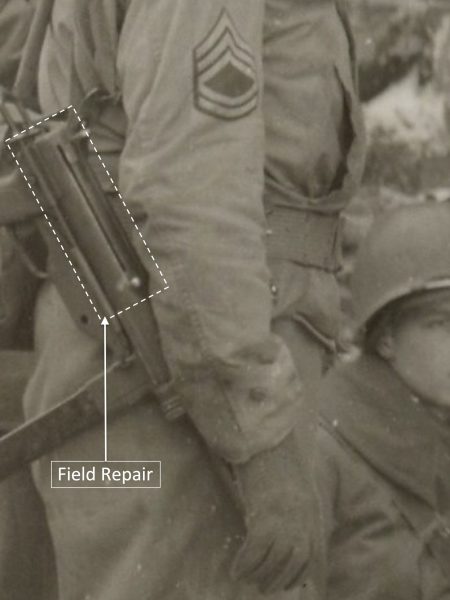
An officer in the headquarters of the 253rd Armored Field Artillery Battalion/6th Armored Division reads the “Articles of War” to his men on January 20, 1945 in the village of Mageret, Belgium three miles east of Bastogne. Note the Sergeant First Class at far left is armed with a field modified M3 submachine gun. (Official U.S. Army photograph)
On numerous occasions during the closing months of 1944, U.S. Army soldiers dropped M3 Grease Guns in such a way that they broke off crank handles. With no retracting mechanism, the bolt could not be drawn to the rear and, the weapon could not be used. At the time, the Army’s ordnance companies were ready to repair just about any infantry weapon in inventory, but not the brand new Grease Gun. In the rush to develop and the adopt the weapon, the potential for breakage of the inherently vulnerable crank handle was overlooked with the result that, when it finally began to happen in France after the D-Day, there was no prescribed method of repairing the problem and, more importantly, no spare parts. This meant that repairmen had to improvise and make due with what they had on hand.
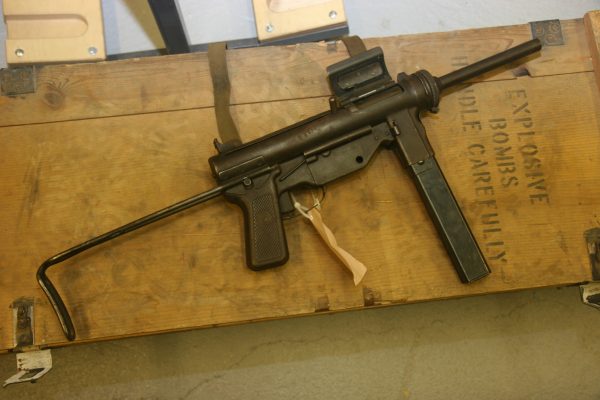
A field modified M3 submachine gun in the collection of Musée National d’Histoire Militaire (the National Military History Museum) in Diekirch, Luxembourg. The weapon’s crank handle has been removed, a slot has been cut in the receiver and a makeshift cocking handle has been added to the bolt.
The solution was straightforward and simple: ordnance company personnel started by removing what was left of the retracting handle assembly from each damaged weapon, then used an end mill to cut a seven-inch long slot into the right hand side of the receiver at the 2 o’clock position running from just behind the weapon’s ejection port. This accommodated a crudely hewn steel bolt handle that inserted through an enlarged opening at the forward end of the slot and entered a hole drilled into the back end of the bolt assembly. It was not a pretty repair, but it worked. A few archival photographs of men from General George Patton’s Third Army taken around the time of the Battle of the Bulge show Grease Guns repaired in this manner. In addition to that, the collection of Musée National d’Histoire Militaire (the National Military History Museum) in Diekirch, Luxembourg has in its collection five M3s that have received this field modification. Considering the fact that the Third Army operated in Luxembourg during and after the Battle of the Bulge, it looks like this field modification may have been confined to the ranks of that specific unit. Interestingly enough though, a product improvement was already in development back in the USA that would make this design shortcoming superfluous.
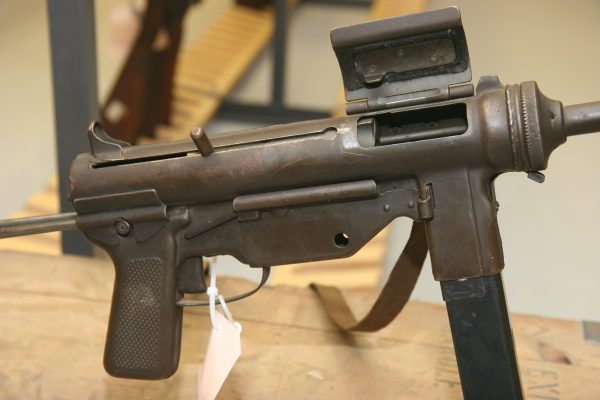
A field modified M3 submachine gun in the collection of Musée National d’Histoire Militaire (the National Military History Museum) in Diekirch, Luxembourg. The weapon’s crank handle has been removed, a slot has been cut in the receiver and a makeshift cocking handle has been added to the bolt.
As early as April 1944, Guide Lamp was working on the modified M3E1 submachine gun. In addition to a number of other design refinements, it featured the complete elimination of the M3’s crank handle assembly and its replacement with a simplified, and indestructible, finger hole in the bolt. The substantial weight of the M3’s bolt was such that the pressure exerted by the weapon’s dual mainsprings was only eighteen-pounds. This meant that the old crank handle apparatus was not just unnecessarily complex, it was unnecessary altogether because the physical effort of retracting the bolt could be managed comfortably by the shooter’s index finger alone. No lever device necessary. On December 21, 1944, the M3E1 was officially adopted as the .45-caliber submachine gun, M3A1 – coincidentally at the same time that field modified M3s were fighting the German onslaught 4,000 miles away in the Ardennes Forrest. Although the fragile crank handle issue was fully resolved with the introduction of the M3A1, the crude and yet perfectly functional field modification that it produced nevertheless says something complimentary about ordnance technicians during World War II. When confronted with a significant repair job on a new weapon with no replacement parts available, they had to adapt, adjust and overcome, and they had to do it quickly. It is a testament to the skill and know-how of these Army gunsmiths that they came up with a practical solution under less than ideal circumstances.
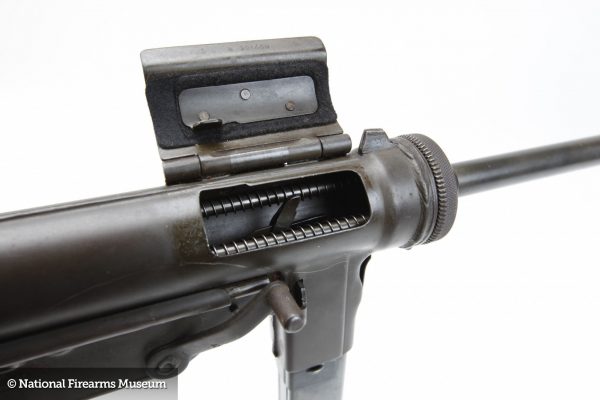
A close-up view of M3 submachine gun #0061260 showing its bolt retracting “crank handle” and ejection port. (Photo courtesy of the National Firearms Museum)
The post The Modified M3 Grease Gun in WWII appeared first on World War Media.
]]>The post The Soldier And The Little Girl appeared first on World War Media.
]]>by Brad Hoopes
But as Roy and his unit follow the war across Europe, he sees the results of war: the total destruction, the death and maiming, the desperate people along the roads begging for food. I can tell in his eyes and in his voice that 65 years later it still bothers him very much. As he is telling me of his experiences in the war, within it he tells of a 3-week period when he receives a wonderful reprieve from it all.
This period of very fond memories for Roy starts when his unit pulled into Heerlen, the Netherlands to set up their headquarters. He is billeted with a local family and soon becomes very close to them, in particular with one of the young daughters, Irmine. “They were incredibly kind to me and the other soldier staying there and treated us like members of the family,” he recalled. One memory in particular that stands out is the warm feeling and sense of family he misses, but now feels when he goes to Christmas Eve services with the family. He and Irmine play games and take walks. He often brings them supplies when he can. He laughs when he tells about once bringing cans of sweet corn and being stumped by their reaction. He soon finds out that back then corn is only eaten by the livestock. Chocolate on the other hand is like gold to them. As the front line starts moving east towards Germany, it is time for Roy to move as well. While saying his goodbyes to the family, he is presented a braid of hair by Irmine’s sister Illa. She cut it off to give him a memento to remember them all by. Roy carries that braid with him through the rest of the war. Sadly however, on the troop ship home after the war had ended, an outbreak of scabies forces everyone to toss all of their personal items overboard.
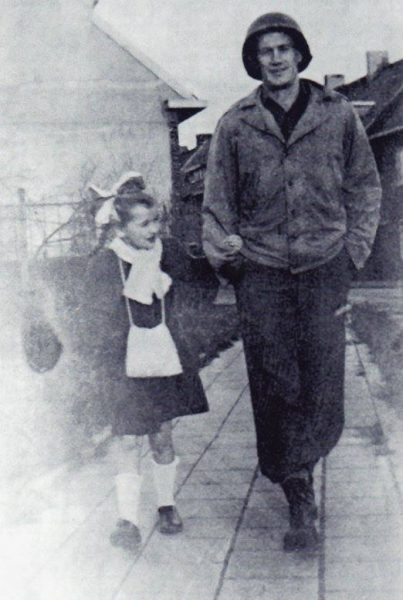
That evening as I am processing his videotaped interview to give back to him and his family, I can’t stop thinking about this story. I have done many interviews and almost every one of them has had an affect on me. Roy’s story is no exception, the only difference being this time it is a happier story. I toss and turn in bed that night thinking about it. Once again, by the sparkle in his eyes I can tell just how special this time and family is to him. When I finally do fall asleep, like many of the other stories I have heard in the past, it seeps into my dreams. When I wake up that next morning, I decide I must try and find Irmine.
Finding Irmine proves to be easy, a testament to the power of the internet. I don’t have her last name or an address, but I do have pictures. I find the website of the local newspaper in Heerlen. Plugging words into a translation website, I work my way around the newspaper’s site until I find their “news tips” button. I send them a message explaining what I am trying to do and ask if they can help. A week goes by with no response and I begin to wonder what other approaches I can take. I then receive an email from Stefan Gillisson, a reporter with the newspaper, saying he would be interested in doing such a story. We exchange additional emails in which I give him what details and pictures I have. He says the story will run the following Saturday. Friday night, like the night after I first interviewed Roy, I toss and turn in bed. Finally very early in the morning, I get up and turn on the computer. With the time difference between the Netherlands and Colorado, I hope there will be good news. There is an email from Stefan….Irmine has been found!

Soon after, I get an email from Irmine’s neighbor Frank. Because she has read in the article about how much that Christmas Eve service meant to Roy, Frank and Irmine go over and snap a picture of her in front of the church and email it to me. I receive a number of emails from others as well. What strikes me about every email I get is that each mentions additionally just how grateful they still are for what the Americans had done. I wait then for a decent hour to call Roy and his wife Marilyn. I had not told them I was doing this, waiting instead to do so when I had something to give them. I take all the emails and the picture of Irmine over to them. I also take my video camera. They record a message to Irmine and I send it to her via Youtube. A few days later Irmine and Frank sent them a video message back. The story only gets more special and touching though once Irmine tells her side of it.
Irmine tells her side of the story when Stefan does a follow up article after she is found. She pulls out her wartime diary and shows where Roy had written a message in it:
To my little darling. Of all the girls in the world, you have made me most happy. You
see, I have a little darling (a special niece) back in America. While I am in Holland, you have
been like that little girl. I hope you will grow up to be a grand lady like your mother. May
you always be happy and stay as beautiful as you are today. Love you baby. Yours, Roy
She talks about the games they play and walks they take. She also told about the time Roy announces a great general was in their town. Irmine’s mother wraps a red, white and blue shawl around her, and she and Roy walk hand in hand to go meet the general. She sits on the general’s lap and he gives her a bag of donuts. As a little girl, she had no idea who General Eisenhower is.
Roy returns home after the war, goes into the printing business and marries his lovely wife Marilyn. They have been married for sixty-four years and have five sons (sadly, losing one in an auto accident), nine grandchildren and one great-grandchild. Irmine will go on to start a program in the Netherlands that helps children in third world countries. She is married to her husband Peter for forty-five years until his passing six months earlier. In the follow up article Irmine states, “I miss Peter very much. Roy’s search comes at the right moment. It lightens my heart and eases the sadness.”
Sadly, a few months after she and Roy reconnected, Irmine passed away.
The post The Soldier And The Little Girl appeared first on World War Media.
]]>The post 80 Years Ago: The Hindenburg Disaster appeared first on World War Media.
]]>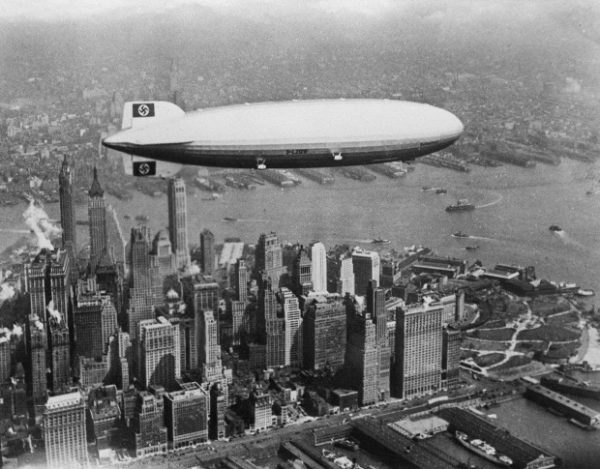
The disaster killed 35 persons on the airship, and one member of the ground crew, but miraculously 62 of the 97 passengers and crew survived.
After more than 30 years of passenger travel on commercial zeppelins — in which tens of thousands of passengers flew over a million miles, on more than 2,000 flights, without a single injury — the era of the passenger airship came to an end in a few fiery minutes.
Actual construction of LZ-129 began in the Fall of 1931, but progress lagged due to a severe lack of funds during the Depression. At first, the Nazi Party’s assumption of power in January, 1933 had little effect on the fortunes of the Zeppelin Company, partly due to Air Minister Hermann Göring’s dislike of lighter-than-air flight. But Propaganda Minister Joseph Goebbels was aware of the potential symbolic value of LZ-129 as a showcase for German strength and technology, and in 1934 Goebbels offered Hugo Eckener 2 million marks toward the completion of LZ-129.
Nazi officials were very much aware of the symbolic value of the huge and impressive airship, and frequently called on Hindenburg for propaganda flights, often in company with the Graf Zeppelin.
Hindenburg made appearances at public events such as the 1936 Berlin Games and the Nuremberg Party rally, and Hindenburg’s first major flight, after test flights were completed, was a 74-hour propaganda flight in support of Hitler’s remilitarization of the Rhineland.
The Disaster
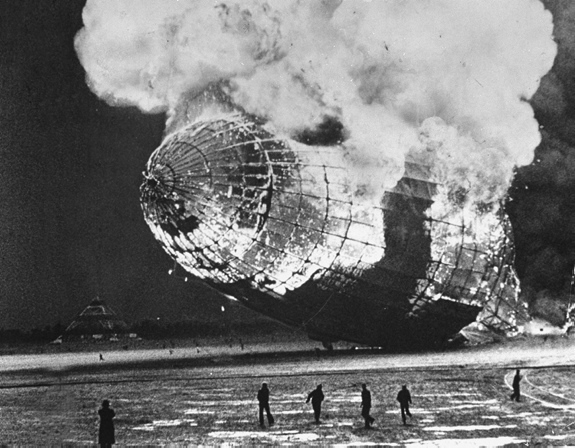
At 7:25 p.m. local time, the Hindenburg caught fire and quickly became engulfed in flames. Eyewitness statements disagree as to where the fire initially broke out; several witnesses on the port side saw yellow-red flames first jump forward of the top fin near the ventilation shaft of cells 4 and 5. Other witnesses on the port side noted the fire actually began just ahead of the horizontal port fin, only then followed by flames in front of the upper fin. One, with views of the starboard side, saw flames beginning lower and farther aft, near cell 1 behind the rudders. Inside the airship, helmsman Helmut Lau, who was stationed in the lower fin, testified hearing a muffled detonation and looked up to see a bright reflection on the front bulkhead of gas cell 4, which “suddenly disappeared by the heat”. As other gas cells started to catch fire, the fire spread more to the starboard side and the ship dropped rapidly. Although there were cameramen from four newsreel teams and at least one spectator known to be filming the landing, as well as numerous photographers at the scene, no known footage or photograph exists of the moment the fire started.
Wherever they started, the flames quickly spread forward first consuming cells 1 to 9, and the rear end of the structure imploded. Almost instantly, two tanks (it is disputed whether they contained water or fuel) burst out of the hull as a result of the shock of the blast. Buoyancy was lost on the stern of the ship, and the bow lurched upwards while the ship’s back broke; the falling stern stayed in trim.
As the tail of the Hindenburg crashed into the ground, a burst of flame came out of the nose, killing nine of the 12 crew members in the bow. There was still gas in the bow section of the ship, so it continued to point upward as the stern collapsed down. The cell behind the passenger decks ignited as the side collapsed inward, and the scarlet lettering reading “Hindenburg” was erased by flames as the bow descended. The airship’s gondola wheel touched the ground, causing the bow to bounce up slightly as one final gas cell burned away. At this point, most of the fabric on the hull had also burned away and the bow finally crashed to the ground. Although the hydrogen had finished burning, the Hindenburg’s diesel fuel burned for several more hours.
The time that it took from the first signs of disaster to the bow crashing to the ground is often reported as 32, 34 or 37 seconds. Since none of the newsreel cameras were filming the airship when the fire started, the time of the start can only be estimated from various eyewitness accounts and the duration of the longest footage of the crash. One careful analysis by NASA’s Addison Bain gives the flame front spread rate across the fabric skin as about 49 ft/s (15 m/s) at some points during the crash, which would have resulted in a total destruction time of about 16 seconds (245m/15 m/s=16.3 s).
Some of the duralumin framework of the airship was salvaged and shipped back to Germany, where it was recycled and used in the construction of military aircraft for the Luftwaffe, as were the frames of the LZ 127 Graf Zeppelin and LZ 130 Graf Zeppelin II when both were scrapped in 1940. SOURCE
The post 80 Years Ago: The Hindenburg Disaster appeared first on World War Media.
]]>The post Coach Bill Belichick Narrates New Documentary D-Day: Over Normandy appeared first on World War Media.
]]>
The documentary, narrated by the NFL’s only 5 time-winning Super Bowl head coach, the New England Patriots Bill Belichick, was shot entirely by drone camera in Normandy, France and combines that incredible footage with interviews with both Allies and German veterans who fought on the exact locations the drone captured in Normandy and Europe.
It will begin premiering nationally in early May. All of TGM/WWII Foundation’s films are donated to American Public Television as part of APT’s Exchange Program. The donation is in-line with the World War II Foundation’s educational mission to preserve the stories of the WWII generation.
The film makes it’s domestic world premiere on May 27th in Providence, Rhode Island and then shows for the first time in Europe on June 3rd at the Utah Beach Museum in Normandy, France.
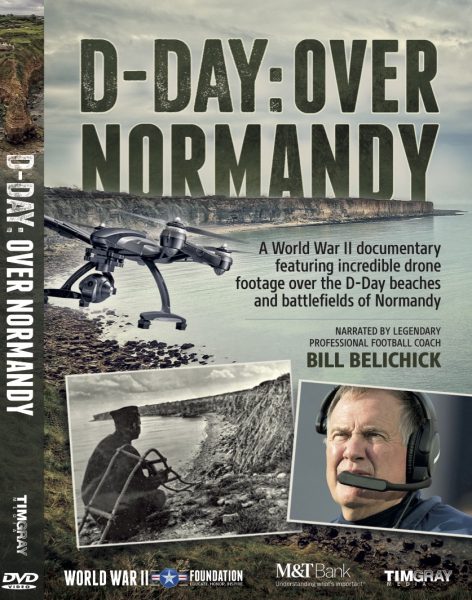
The post Coach Bill Belichick Narrates New Documentary D-Day: Over Normandy appeared first on World War Media.
]]>The post In 2005, a 83 Year-old World War II pilot Saw Footage of His 1944 Spitfire Crash For the First Time appeared first on World War Media.
]]>
The post In 2005, a 83 Year-old World War II pilot Saw Footage of His 1944 Spitfire Crash For the First Time appeared first on World War Media.
]]>The post 109 Year Old WWII Veteran and His Secrets to Life appeared first on World War Media.
]]>
This supercentenarian has lived through the Great Depression, served in World War II, and witnessed the rise of the Internet. From the Ford Model T to self-driving cars, more technological and scientific progress have occurred in Overton’s lifetime than perhaps any other century in history. Overton enlisted in the U.S. military on September 3, 1940 at Fort Sam Houston, Texas. He served in the South Pacific from 1940 through 1945, including stops in Hawaii, Guam, Palau and Iwo Jima. He left the U.S. Army in October 1945 as a corporal, technician fifth grade.
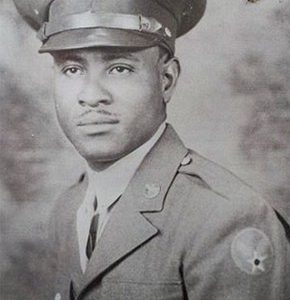
In a short film featured by National Geographic, the Austin, Texas, resident reveals that he sometimes smokes more than 12 cigars a day, and drinks four glasses of whiskey in the morning. “It makes you feel better,” he says. The supercentenarian prescribes to the “Overton diet,” saying, “I eat ice cream every night. It makes me happy.” His favorite flavor is butter pecan. When he’s not in the mood for dessert, Overton also enjoys milk, fish, corn and soup, which is underrated in his opinion.
Richard Overton was even featured in Cigar Aficionado Magazine as America’s oldest cigar smoker. He told the publication that putting a little bourbon in your morning coffee is “like medicine.”
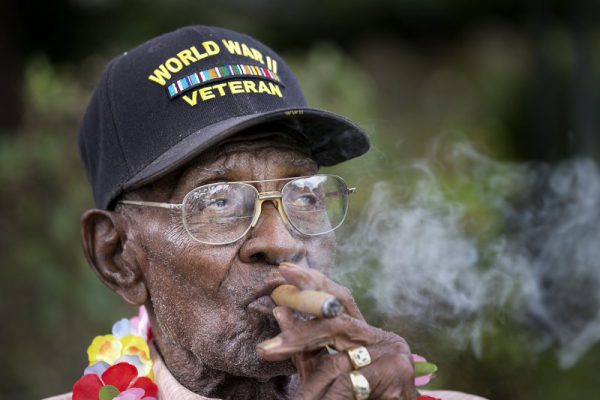
The post 109 Year Old WWII Veteran and His Secrets to Life appeared first on World War Media.
]]>The post Call of Duty: WWII appeared first on World War Media.
]]>
Play through the story of ordinary men turned soldiers in the 1st Infantry Division as they fight to preserve freedom in the face of tyranny. Call of Duty: WWII delivers fast-paced, boots-on-ground combat through iconic locations in the European Theater.
To stay as close as possible to historical accuracy, Sledgehammer worked closely with noted author and military historian Martin K A Morgan .
Call of Duty: WWII will be released on 3 November 2017 for PS4, Xbox One and PC.
Pre-order Call of Duty: WWII now on-disc or digital download and secure your code for the Private Beta: http://www.CallofDuty.com/WWII
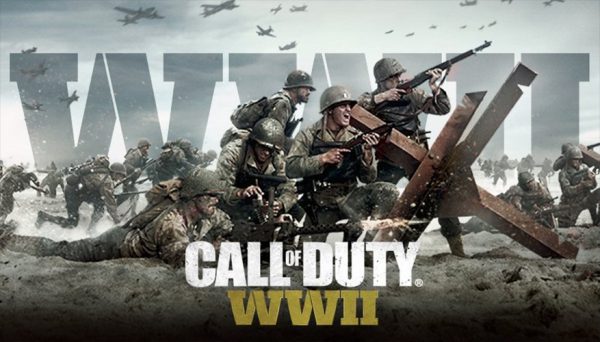
The 1st Infantry Division entered combat in World War II as part of “Operation Torch”, the invasion of North Africa, the first American campaign against the Axis powers. On Nov. 8, 1942, following training in the United Kingdom, men of the First Division landed on the coast of Algeria near Oran. The initial lessons of combat were harsh and many men were casualties in the campaign that followed and which stretched from Algiers into Tunisia. On May 9, 1943, the commander of the German “Afrika Korps” surrendered his force of 40,000 and North African operations for the Big Red One ended. The Division then moved on to take Sicily in “Operation Husky.” It stormed ashore at Gela, July 10, 1943, and quickly overpowered the Italian defenses. Soon after, the Division came face-to-face with 100 tanks of the Herman Goering Tank Division. With the help of naval gunfire, its own artillery and Canadian allies, the First Infantry Division fought its way over the island’s hills, driving the enemy back. The Fighting First advanced on to capture Troina and opened the Allied road to the straits of Messina.
On D-Day, June 6, 1944, the Big Red One stormed ashore at Omaha Beach. Soon after H-Hour, the Division’s 16th Infantry Regiment was fighting for its life on a strip of beach near Coleville-sur-Mer that had been marked the “Easy Red” on battle maps. As the assault progressed, the beach became so congested with destroyed equipment, the dead and the wounded, that there was little room to land reinforcements. Col. George Taylor, commander of the 16th Infantry Regt., told his men, “Two kinds of people are staying on this beach! The dead and those who are going to die! Now, let’s get the hell out of here!” Slowly, spurred by the individual heroism of many individuals, the move inland got underway.
A German blockhouse above the beach became a command post named “Danger Forward.”
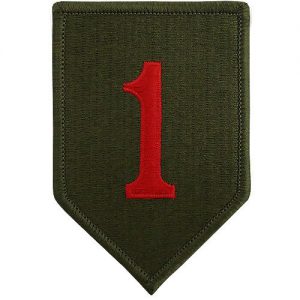
After the beachhead was secured, the Division moved through the Normandy Hedgerows. The Division liberated Liege, Belgium, and pushed to the German border, crossing through the fortified Siegfried line. The 1st Inf. Div. attacked the first major German city, Aachen, and after many days of bitter house-to house fighting, the German commander surrendered the city on Oct. 21, 1944.
The Division continued its push into Germany, crossing the Rhine River. On Dec. 16, 24 enemy divisions, 10 of which were armored, launched a massive counterattack in the Ardennes sector, resulting in what became known as the Battle of the Bulge. The Big Red One held the critical shoulder of the “Bulge” at Bullingen, destroying hundreds of German tanks in the process. On Jan. 15, 1945, the First Infantry attacked and penetrated the Siegfried line for the second time and occupied the Remagen bridgehead. On Easter Sunday, April 1, 1945, the Division marched 150 miles to the east of Siegen. On April 8, the Division crossed the Weser River into Czechoslovakia. The war was over May 8, 1945.
At the end of World War II, the Division had suffered 21,023 casualties and 43,743 men had served in its ranks. Its soldiers had won a total of 20,752 medals and awards, including 16 Congressional Medals of Honor. Over 100,000 prisoners had been taken.
Following the war, the First Division remained in Germany as occupation troops, until 1955, when the Division moved to Fort Riley, Kan. (Source)
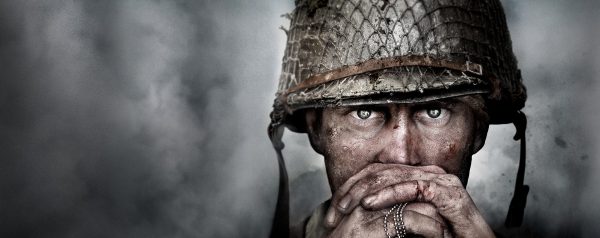
The post Call of Duty: WWII appeared first on World War Media.
]]>
